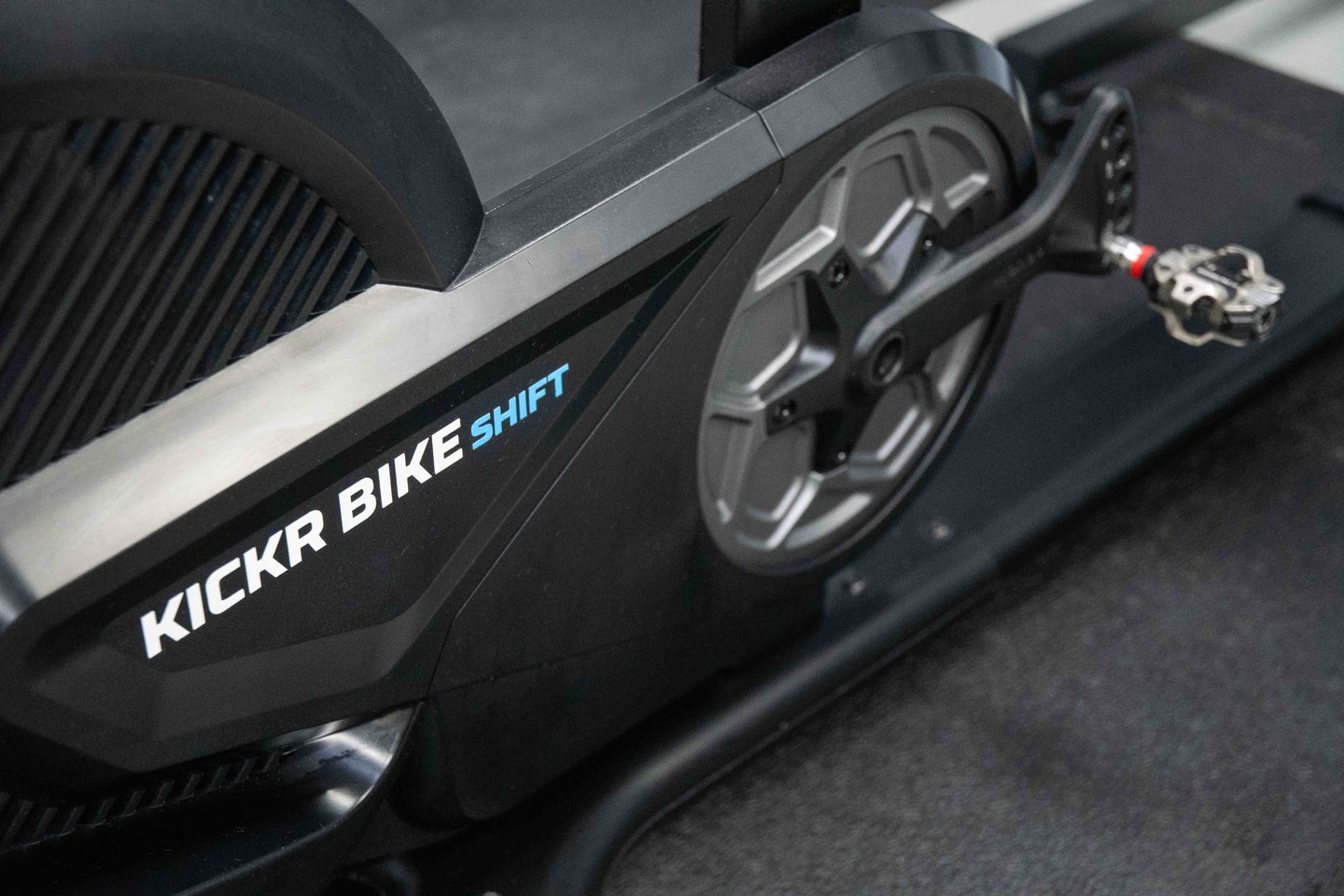
I didn’t exactly intend this review to end up as a long-term review, yet, here we are. After some 9 or so months, this is my complete Wahoo KICKR BIKE SHIFT In-Depth Review. The SHIFT is effectively a pared-down version of the existing Wahoo KICKR BIKE, yet, in some ways it’s actually better. For one, it’s actually silent. Two, it’s got less moving things to break. And three, it’s cheaper.
The KICKR BIKE SHIFT is aimed at being a (slightly) more affordable version than the full KICKR BIKE. The SHIFT is priced at $2,999, instead of the $3,999 for its bigger and older sibling. To get to that price point Wahoo removed a few pieces of hardware to reduce costs, but ironically, I came away largely favoring the cheaper variant.
I’ve been riding it on and off since last fall, before it first announced. You may remember that when I did my first hands-on post on it, I ran into some accuracy issues. Those initially got sorted relatively quickly after that post (via software update), but then I kept running into odd accuracy quirks on and off for another month or so. It’d be great for a week or two, and then boom, an unexplainable accuracy issue. Well, some number of software updates later, and I haven’t had any of those issues for about 6-7 months now. Thus, I think it’s been long enough to call this thing ready for a final review.
With that, let’s dive into it.
How it Differs:
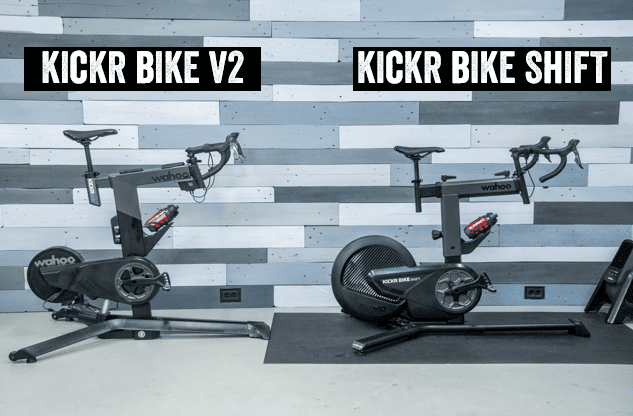
First though, I want to not-so-quickly recap how it differs from the higher-end KICKR BIKE V2 that came out in 2022. This part of the review is reprinted from my earlier first-look post, with some minor tweaks.
While the Wahoo KICKR BIKE SHIFT shares the name with the existing KICKR BIKE V1/V2, technologically, they’re almost entirely different. In fact, even structurally they’re almost entirely different. Everything from the frame design/size/materials is changed, to the entire flywheel/drivetrain system, to how the electronics in the shifters attach. About the only thing that’s the same is the saddle itself (even how it attaches is different), as well as the handlebars (and how those attach/connect is different).
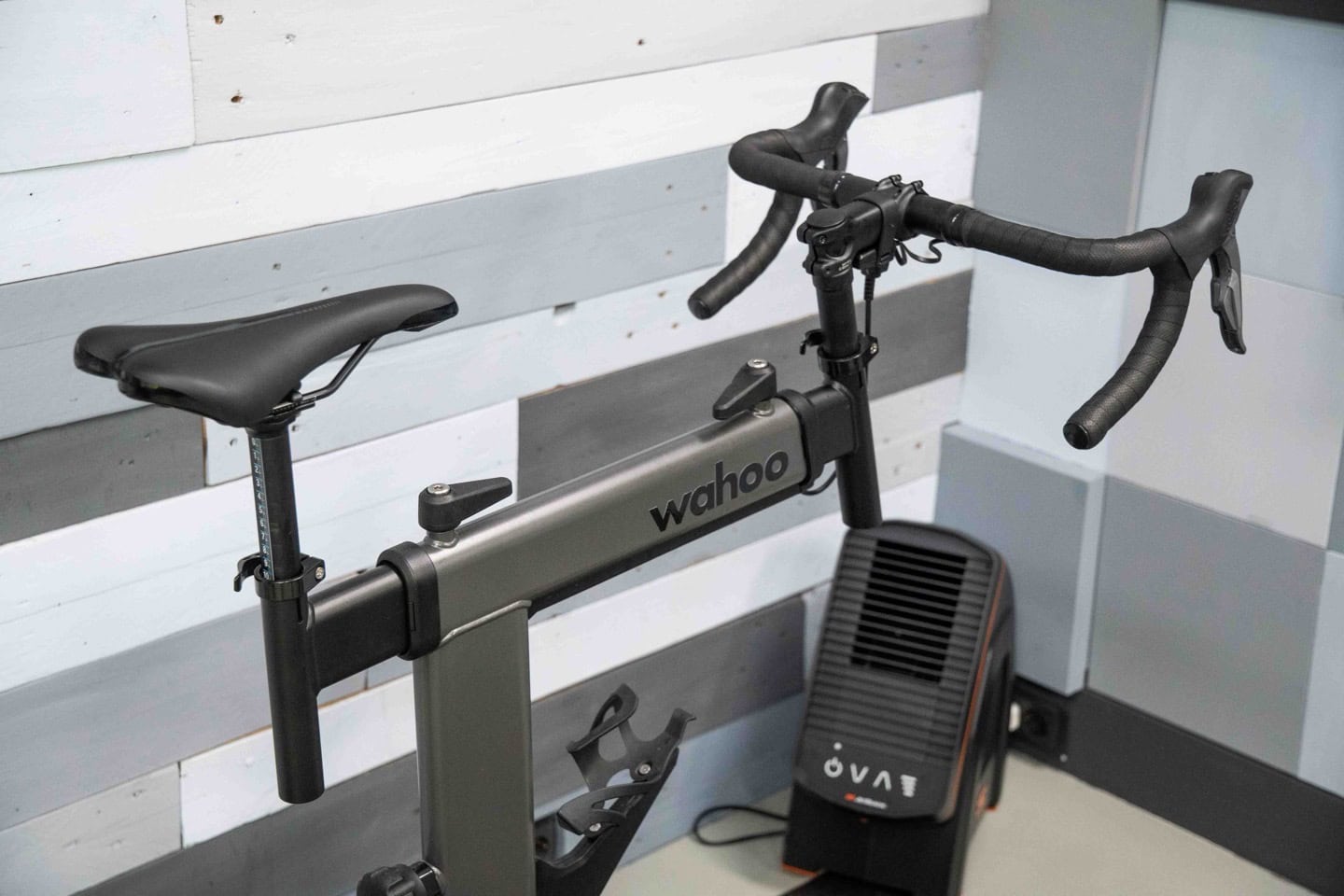
Let’s start out structurally first. You’ll immediately notice the KICKR BIKE SHIFT (aka KICKR Bike Jr) has much thinner components. While a chunk of this is weight savings (and those costs for shipping and material savings), another very real component is that it increases rider compatibility. A very common complaint about the existing KICKR BIKE V1/V2 is that the top-tube is really wide, and would often rub on thighs (mine included), depending on your exact fit. This new frame is much thinner, and I experienced no thigh-rub.
You’ll also notice new styled handles everywhere for this thinner design. On the whole, I don’t think the new handles are better or worse, just…different. Perfectly fine either way. As one who has a KICKR BIKE V1 at home, and has been riding the KICKR BIKE SHIFT at the office, I don’t have any real preference either way.
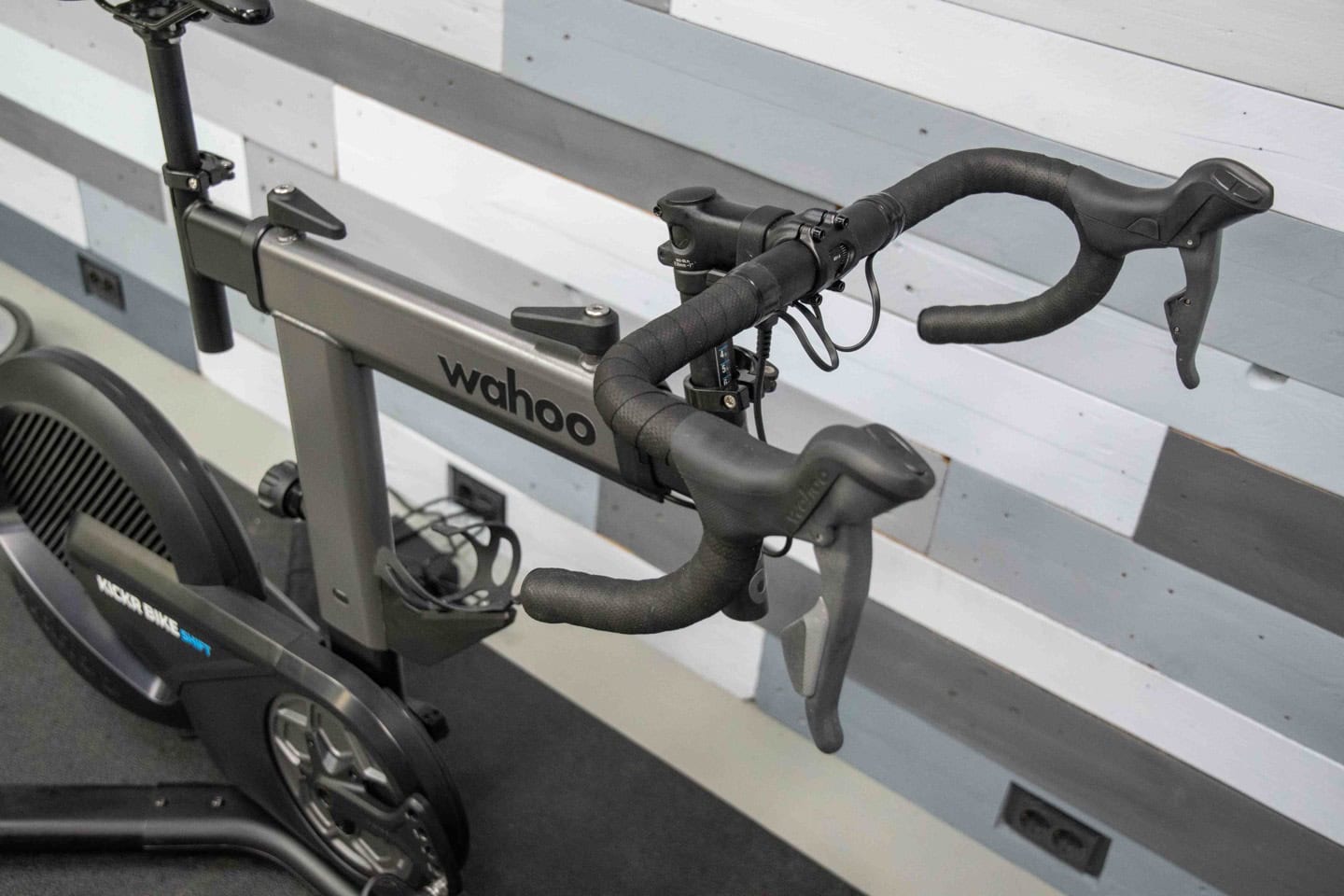
The next notable difference is the new seat post clamp, which has a hex-compatible nut in it, so you can actually crank it down with a hex wrench. Once I did that, then it was rock-solid staying put. I could have had a goat atop a cow style circus act up there, and it’d have stayed exactly in place. Whereas the KICKR BIKE V2 has a hand-friendly clamp, but is more prone to slippage.
Below at left: KICKR BIKE V2, and at right, KICKR BIKE SHIFT:
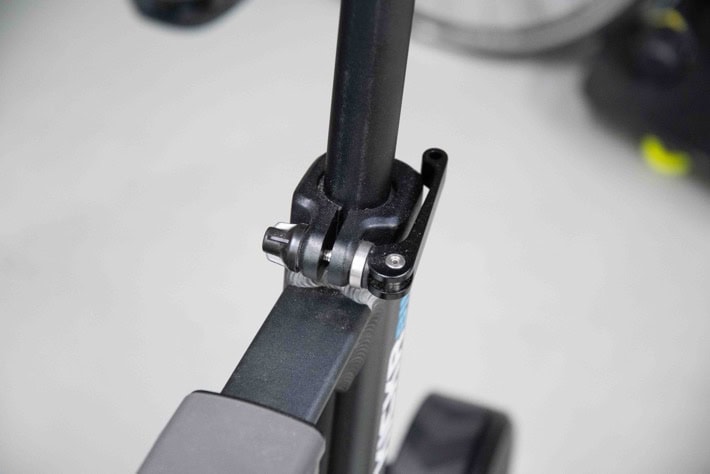
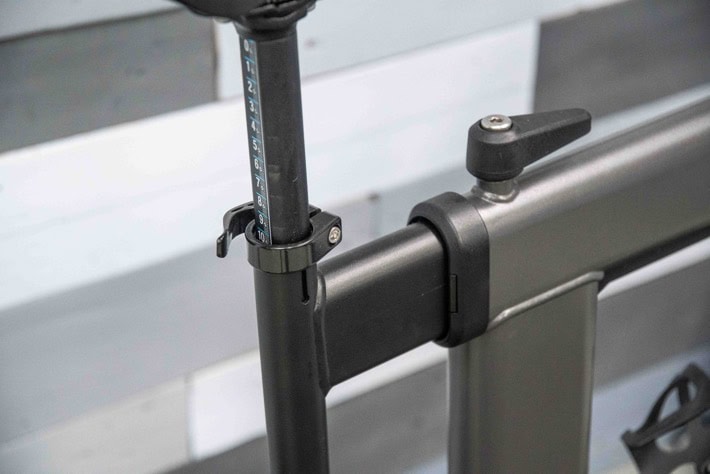
I asked whether or not the various markings on the KICKR BIKE V1/V2 were identical to the KICKR BIKE SHIFT markings (from a fit/sizing standpoint), and they said while they are very similar, things are slightly different by a few millimeters. However, if you use the Wahoo app to input your fit coordinates (such as from a bike fitting system), it’ll spit out the correct markings for whichever version of the bike you’re using.
Meanwhile, transitioning towards some of the electronics pieces, towards the front you’ll notice a lack of messy wiring. Gone are all the silly cables running everywhere, replaced instead by a kinda-sorta-Di2/AXS junction box style situation. This is where the shifter cables come into, but also where the power runs through, as well as status lights for wireless communications. This is actually magnetically attached:
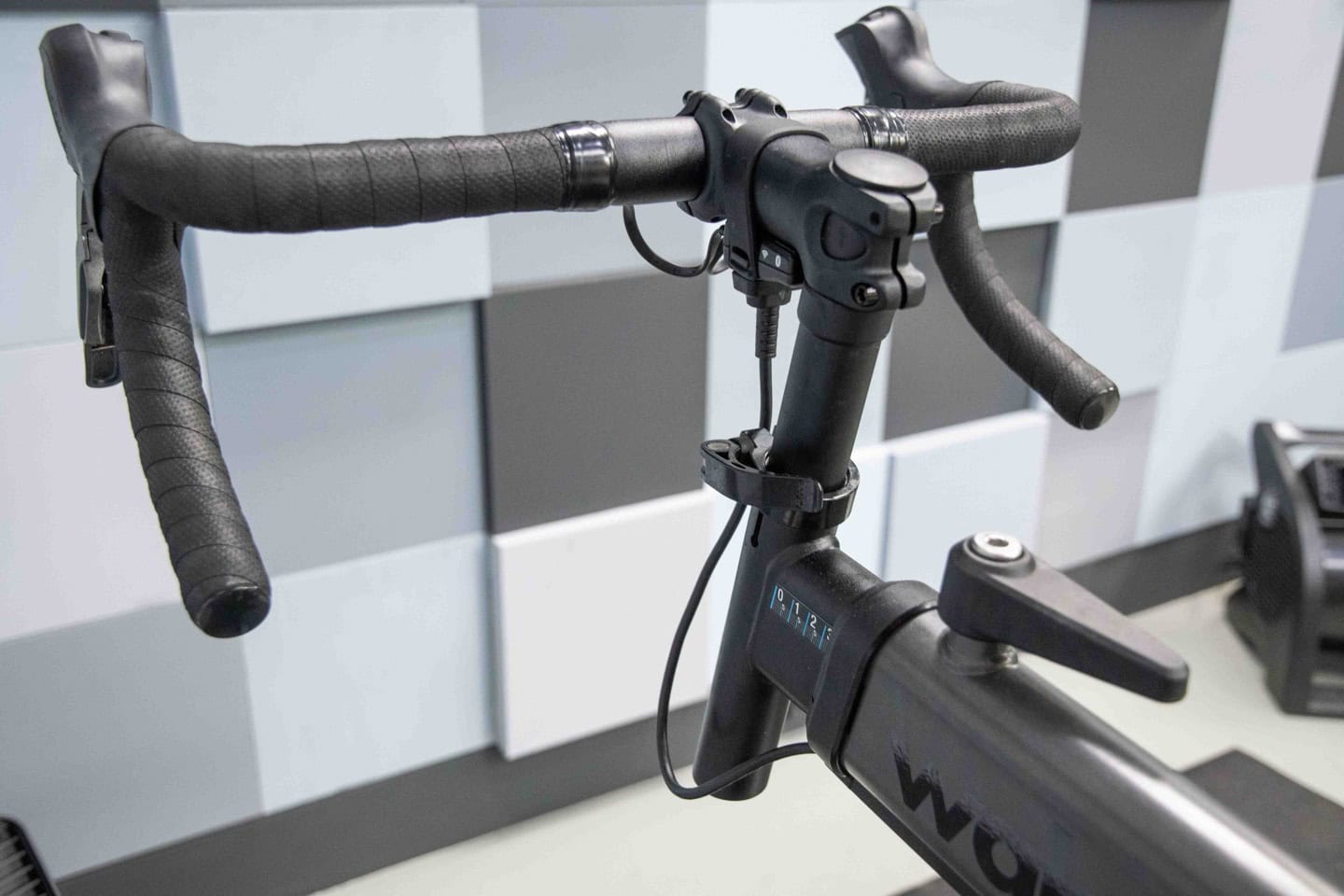
While there was some initial concern about the magnets not being strong enough and potentially disconnecting mid-ride (thus, disconnecting your power broadcast/etc), I’ve never once had that happen on a ride. Not from bumping, nor towel, or anything else. Thus, this has seemingly stood the test of time.
Meanwhile, on the backside of the KICKR BIKE SHIFT we’ve got the entirely new drivetrain/flywheel system. This is not the same motor-driven electromagnetic drivetrain that you have on the KICKR BIKE V1/V2, thus it can’t simulate downhill/forward speeds (e.g., coasting down a hill). It’s more in line with the Wahoo KICKR trainers in terms of how it works. Visually (externally), I kinda like it actually. In any shots where you see ‘white’ or reflecting looks to it, that’s just a crapton of studio lights reflecting off-angle. In person, it’s just black. Albeit, very shiny black.
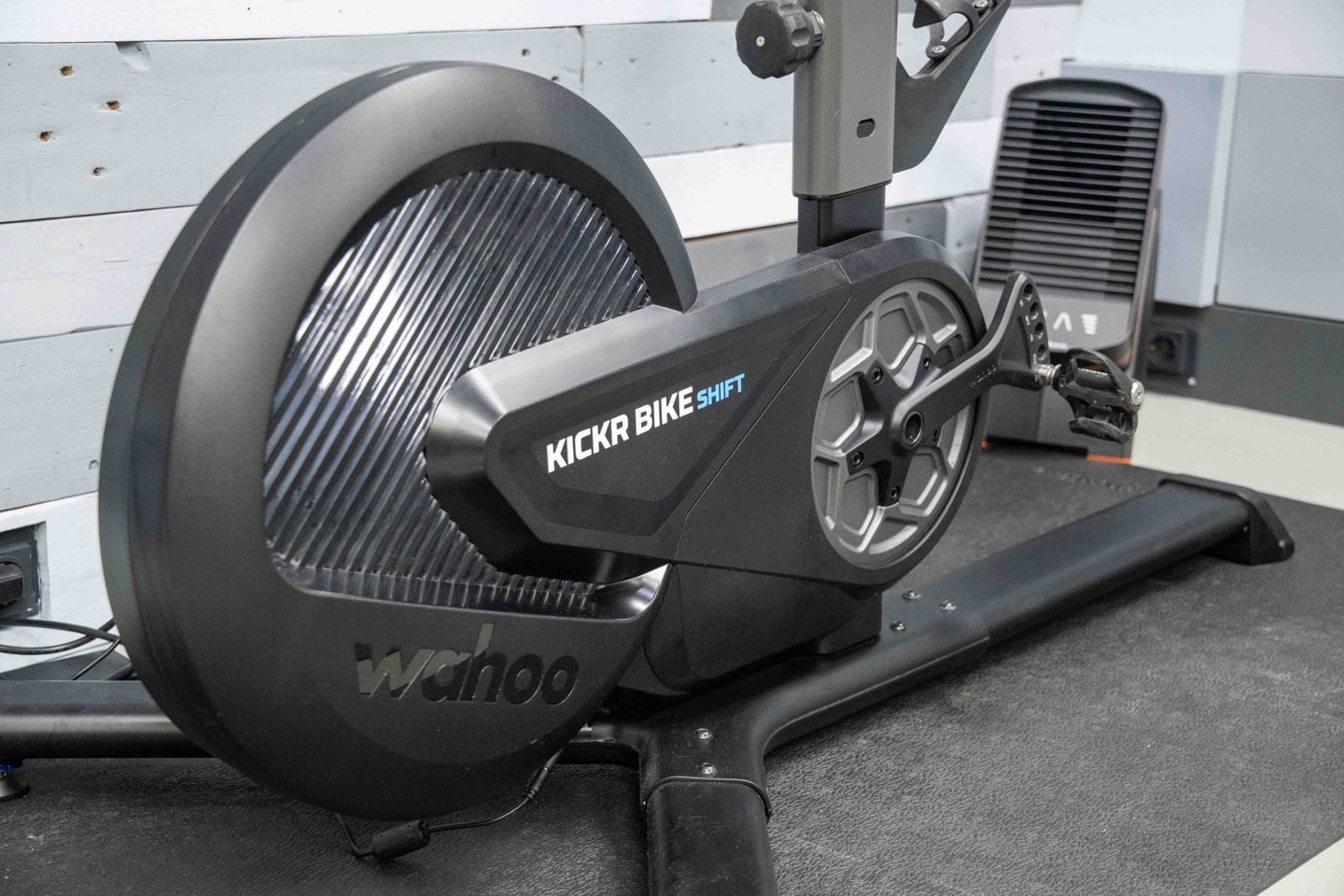
This new drivetrain system is dead-silent. It makes zero sound whatsoever. Not pedaling, not coasting, nothing. Every time I get on the KICKR BIKE V1 (or the other V2 I have floating around), it’s a stark (loud) reminder of the difference.
In fact, that’s not the only quiet thing here – also, the lack of built-in KICKR CLIMB gradient simulation means that it’s mechanically much simpler. No crazy up/down systems, or pivot points. It’s…well…simple. And as such, everything about it is quiet. That’s notable when compared to the KICKR BIKE V1 and V2, which have a long history of slowly getting louder over their individual lifespans. My KICKR BIKE V1 seems to groan and make noises even when I look at it And when I get on and start pedaling? It’s debatably akin to an adult film production set happening down below. Whereas the KICKR BIKE SHIFT is just so effin quiet. It’s insane how quiet by comparison – roughly like a Peloton Bike.
However, the one thing that I did immediately notice is the lack of a physical gearing display. On the KICKR BIKE SHIFT there is no gear indicator/display like there is on the KICKR BIKE V1/V2. That’s particularly challenging in Zwift, since Zwift doesn’t display which gear you’re in for the KICKR BIKE (it does for the Tacx NEO BIke, Wattbike, and probably some others) – but not Wahoo.
During my first-look at this bike nearly a year ago (Sept 2023), Zwift and Wahoo said this was coming for the KICKR BIKE SHIFT. Meanwhile, here we are in June 2024, and it’s still not there. I poked Zwift and Wahoo again, asking who exactly was to blame.
In short, Zwift and Wahoo collectively agreed Zwift was to blame here. It sounds like things are closer than ever, as there’s some updated protocol pieces going into place within Zwift for trainer companies to use in the very near future (a number are already internally testing it). It’s this updated integration point that will allow Zwift to display the KICKR BIKE SHIFT gears. That said, when other companies like Indievelo can do it over a lazy weekend, we shouldn’t have to wait a year for this very basic thing to happen.
Finally, here’s some tech spec stuffs, because, everyone likes tech specs:
– Power Accuracy claim of +/- 1%
– Max 20% simulated incline (of resistance unit)
– Max 2,200w supported resistance
– Zero-calibration software algorithm
– Dual ANT+/Bluetooth Smart support, including ANT+ FE-C, plus power/speed/cadence broadcasting
– Built-in always-on WiFi (2.4 GHz)
– Retains existing KICKR Direct Connect wired port option for connectivity (requires adapter)
– Bike weight: 100lbs/40kgs, max rider weight 250lbs/113.4kgs
– Requires power cable/be plugged in
– Does *NOT* have KICKR Race mode like KICKR BIKE V2 does
In any event, let’s dive into the box.
In the Box & Setup:
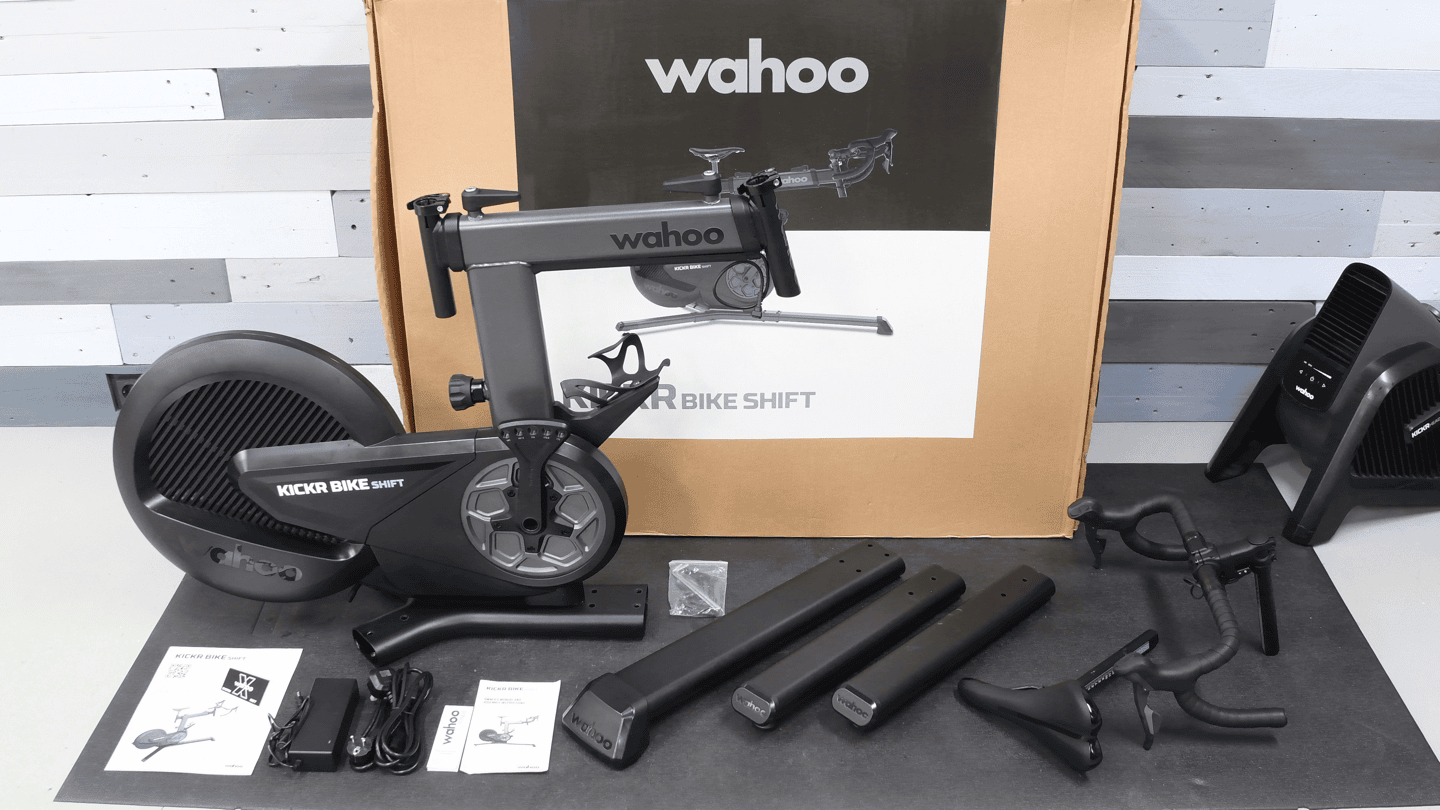
The KICKR BIKE SHIFT setup is thankfully neither complex, nor time consuming. You essentially have the main frame, legs, seat post, and handlebars to slap together. Plus, a decision on pedals.
You’ll first start by attaching the three legs via the few bolts for each leg, giving stability to your rocking horse:

Then, you’ll choose to install the seat post or handlebars next. Obviously, the manual would give you guidance on the proper order, but that’d take the fun out of things. Either scenario is simply sticking it in the hole and tightening the little lever.
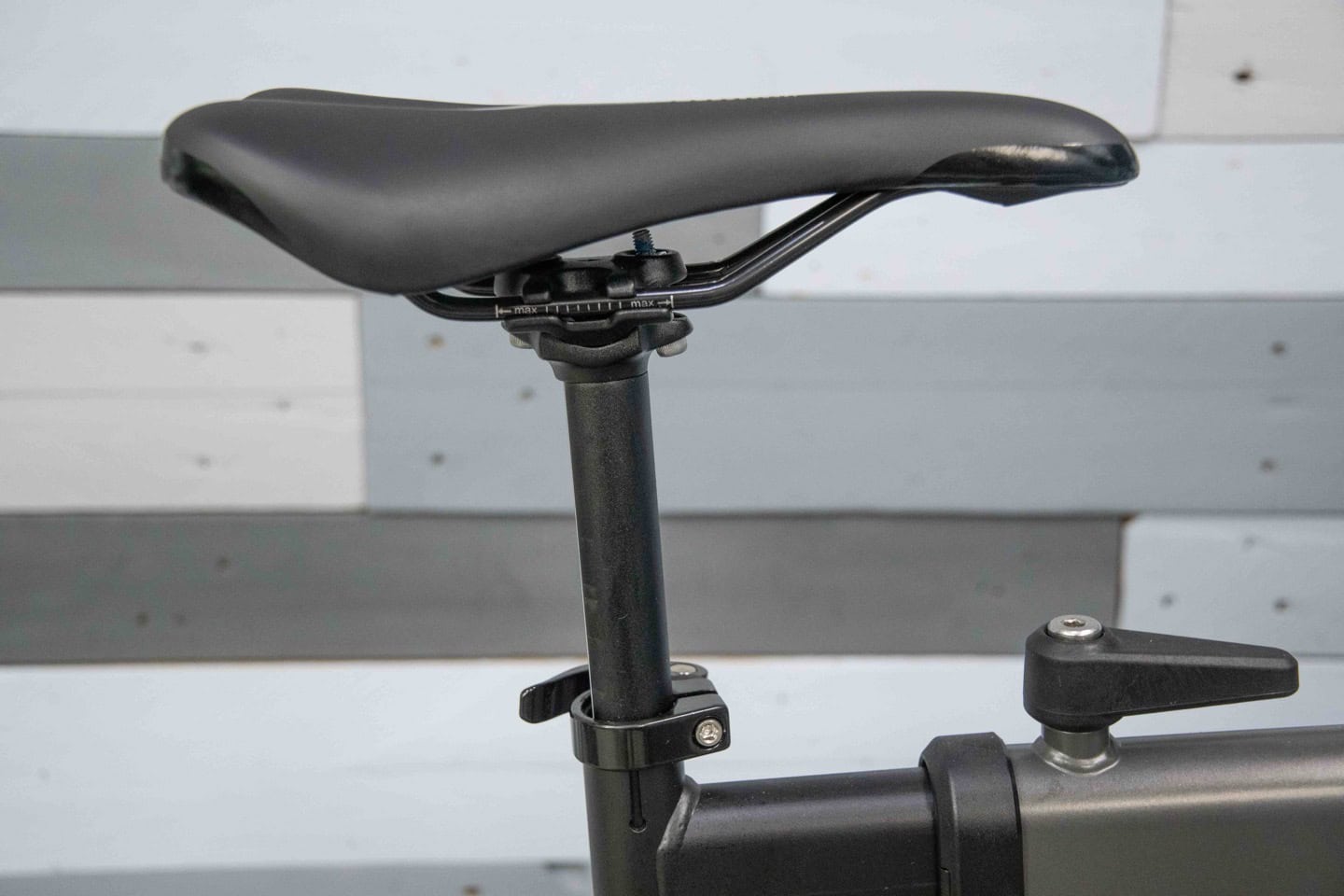
From there, do the other part you didn’t do in the previous step. Insert into hole, tighten lever. Both the seat post and handlebar are designed to adjust of course, for different rider sizes (more on that later).
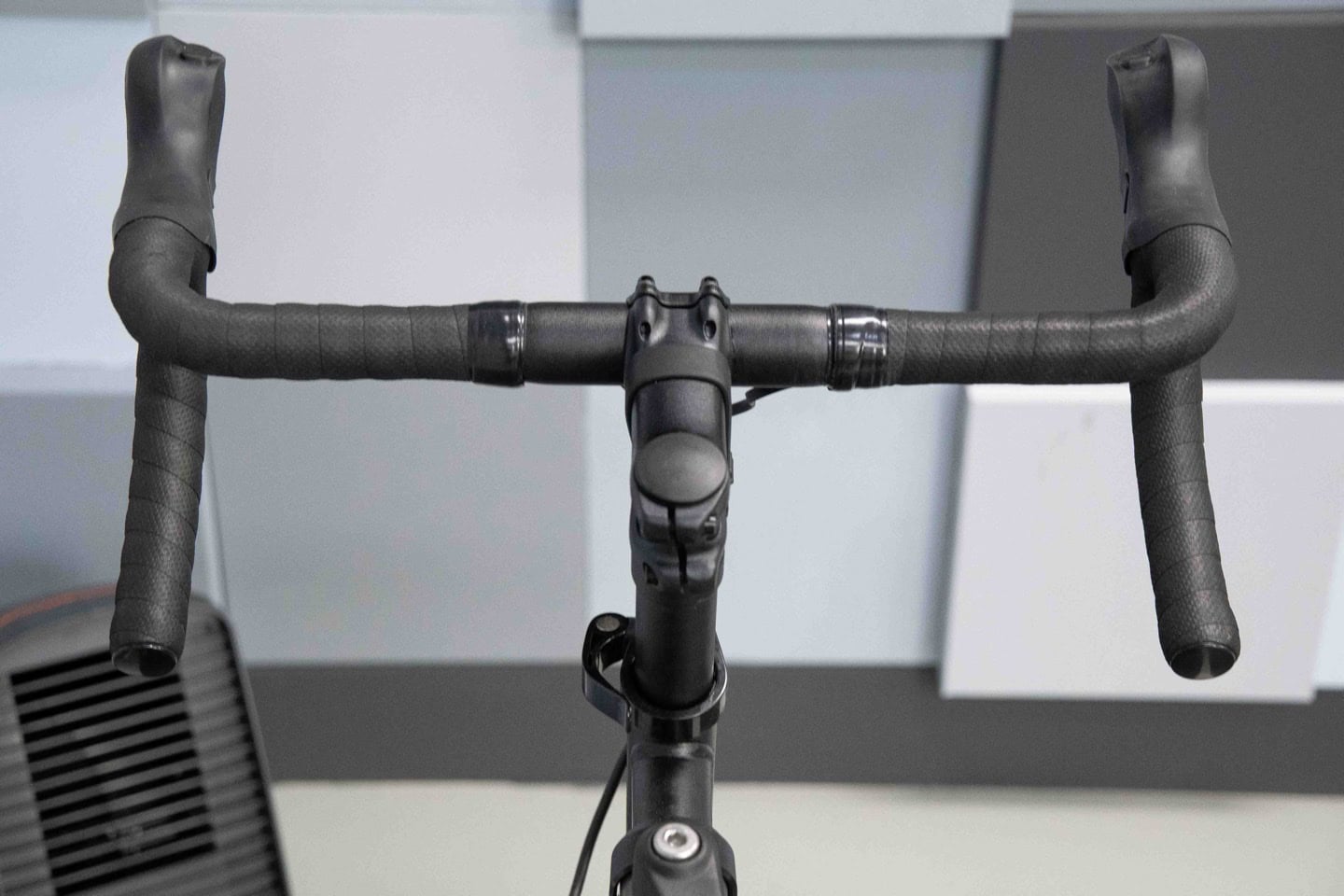
In the case of the handlebar, you’ll want to attach the small magnetic cable to it, which is what powers the connectivity on the handlebars and bike. That power runs from the cable at the back of the bike, past the electronic resistance unit, and ultimately up to the handlebars via this little magnet mount system.
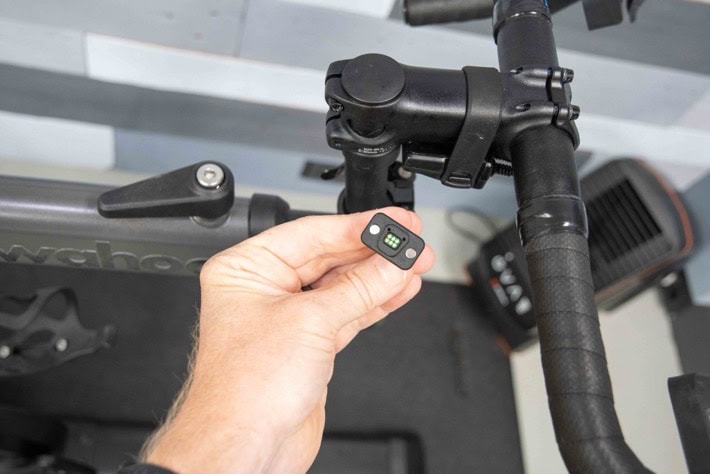
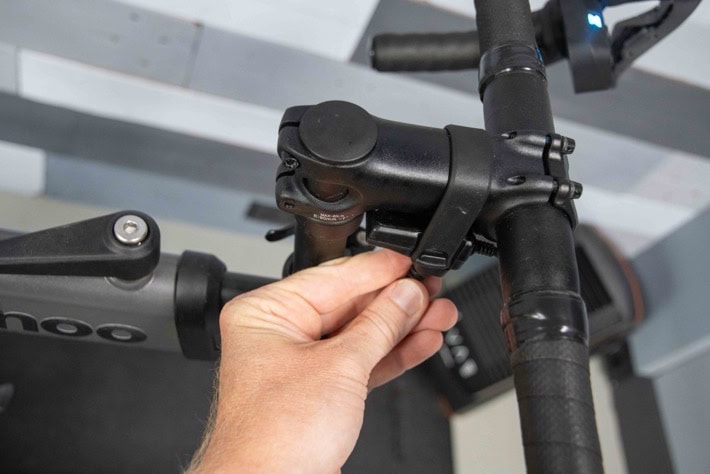
Next, you’ll go ahead and connect up the power supply at the back of the bike. One end into the bike (just below the ‘wheel’-looking thing), and the other end to an outlet of your choosing.
Lastly, stick on some pedals in the appropriate crank length holes. But more on which holes to put them in, in the next section!
With that, we’re ready to start pedaling.
Bike & Rider Fit Options:
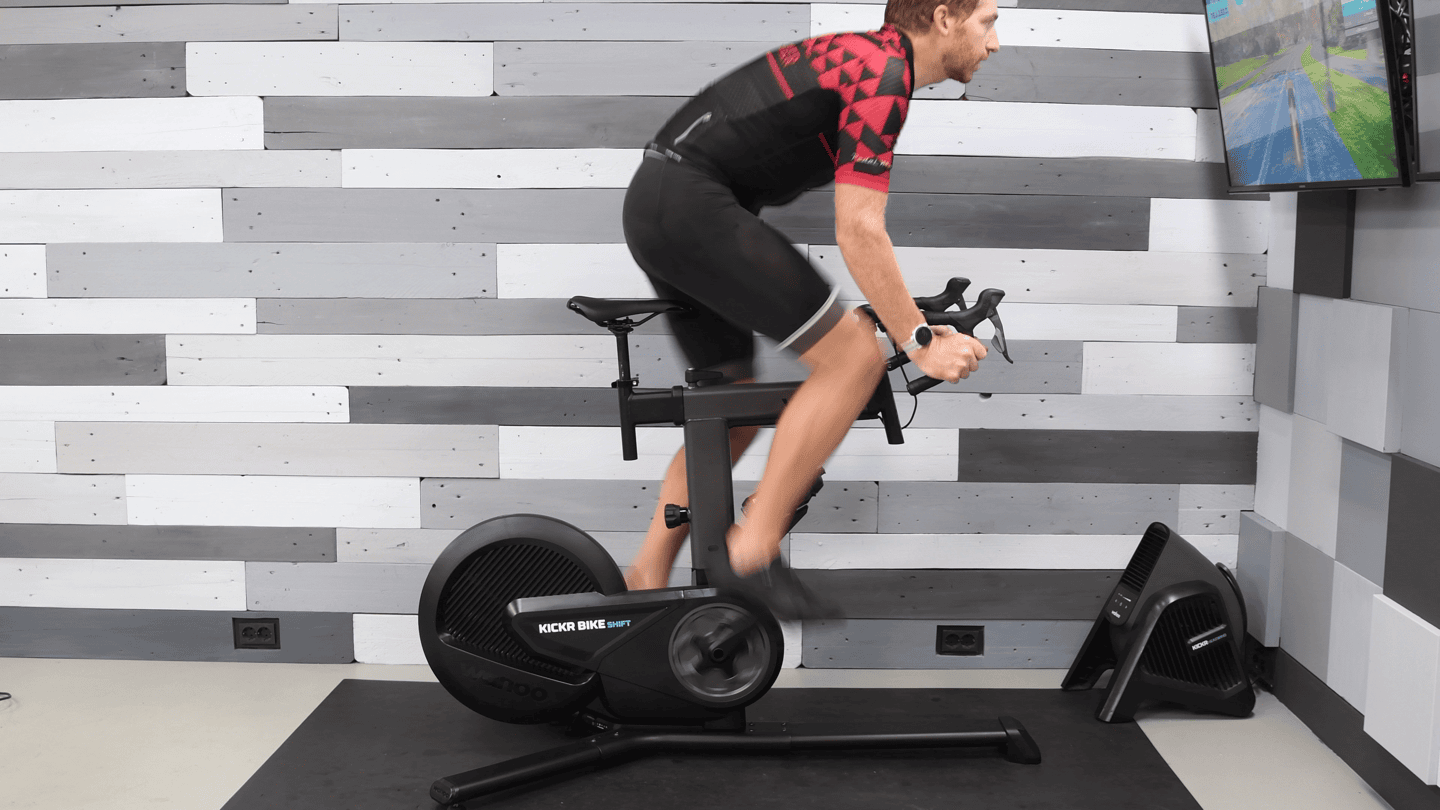
Of course, one of the major reasons people buy indoor smart bikes is to share them within the household with other family members. Thus, adjustability to different rider sizes is pretty important. But in terms of the range of fit options, but also how quickly you can change the bike to adapt to someone else riding it. If the process takes forever, you’re less likely to ride the bike.
In this case, Wahoo changed the handles a bit from the more expensive KICKR Bike to make them a bit less sleek – aligning instead towards more traditional indoor bike adjustment levers. Again, this doesn’t bother me at all.
There are six core ways you can adjust the bike:
1) Saddle height (up/down)
2) Saddle position (forward/back/angle of saddle)
3) Handlebar height (up/down)
4) Handlebar position (forward/back)
5) Stand-over height adjustment (up/down)
6) Crank length
In addition, the seat height is actually two metrics blended together: Stand over height + Saddle height.
Each of these areas has a small ruler on one side, making it easy to write down or memorize the exact measurement for each rider in the family.
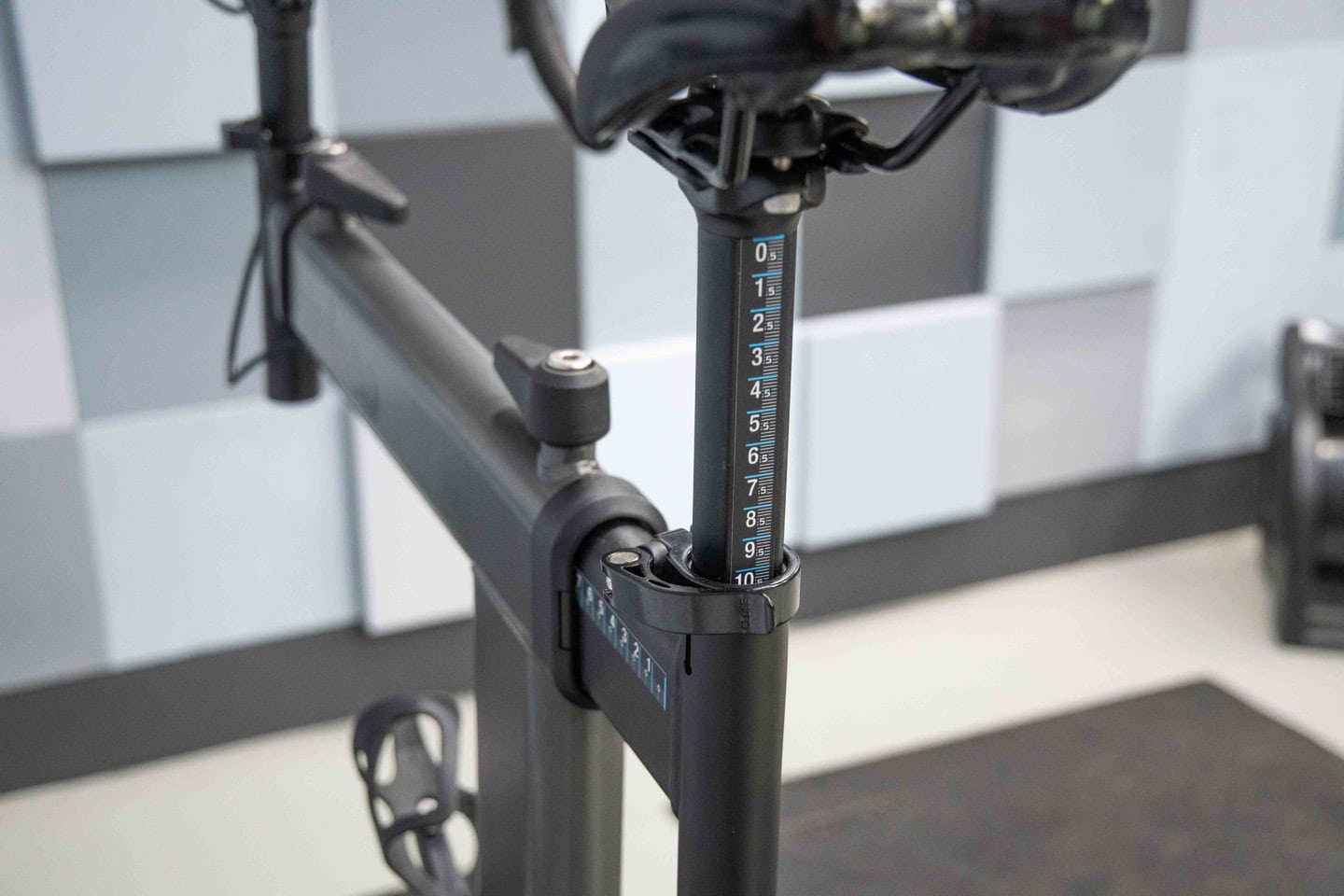
The clamps pop-up to rotate freely, such that they can always be placed ‘out of the way’, and not blocking your legs.
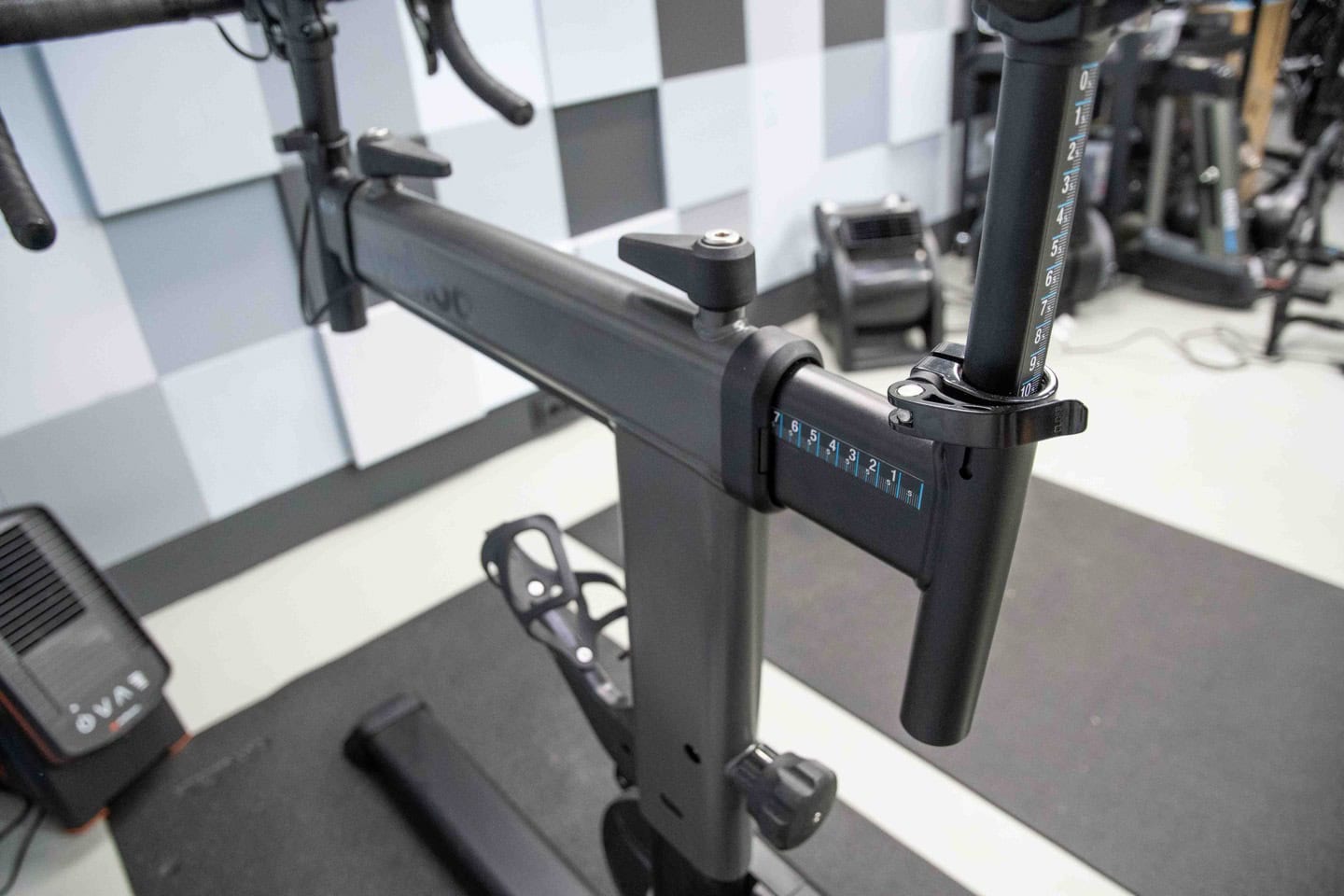
One change that Wahoo has made on the SHIFT compared to the more expensive KICKR BIKE’s, is the seat post clamp design. This new design allows usage of a tool to tighten it up, and is supposed to improve slippage issues. And to a certain degree, it does.
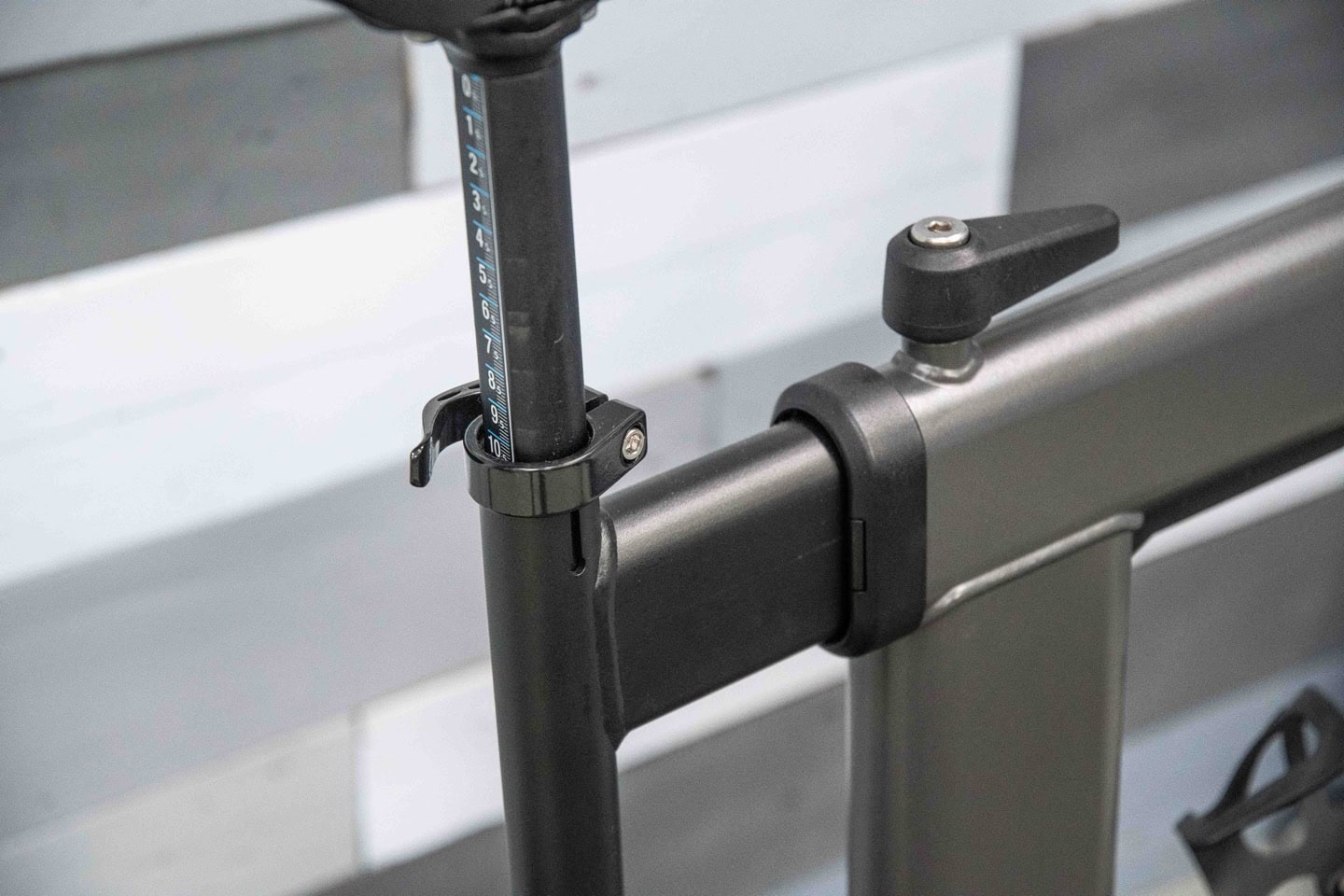
However, the elephant in the room continues to simply be Wahoo’s usage of a non-round seat post. Presumably this is done for style/visual reasons, but it still introduces unnecessary slippage unless you really crank it down. Note that you can simply put your own standard seat post/saddle in there. In fact, that’s what I do at home with my older KICKR BIKE V1, where my wife and I each have different saddles on cheap $9 seat posts. Problem, easily solved.
When it comes to figuring out the right fit, Wahoo has a little calculator/guided system within the Wahoo app. This includes two options:
A) Enter in your height and inseam, as well as preferred position (relaxed/endurance/race) and it’ll give you the KICKR BIKE SHIFT measurements
B) Utilize a well-known bike fit measurement system from GURU Fit System, Retul Fit, or Trek Precision Fit, which will give you the right measurements for the SHIFT.
You can see here some of these screens. It’s all pretty straightforward, but as always, you may want to tweak it slightly based on how it feels after a ride or two:
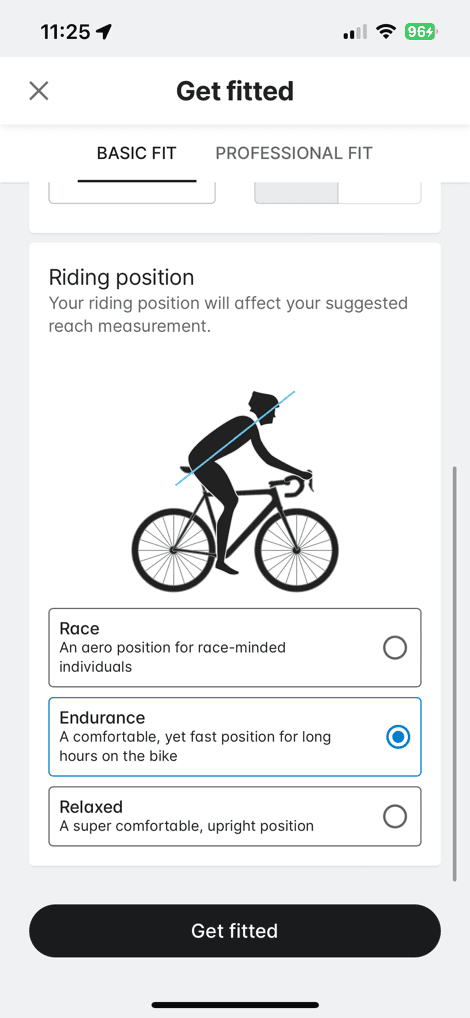
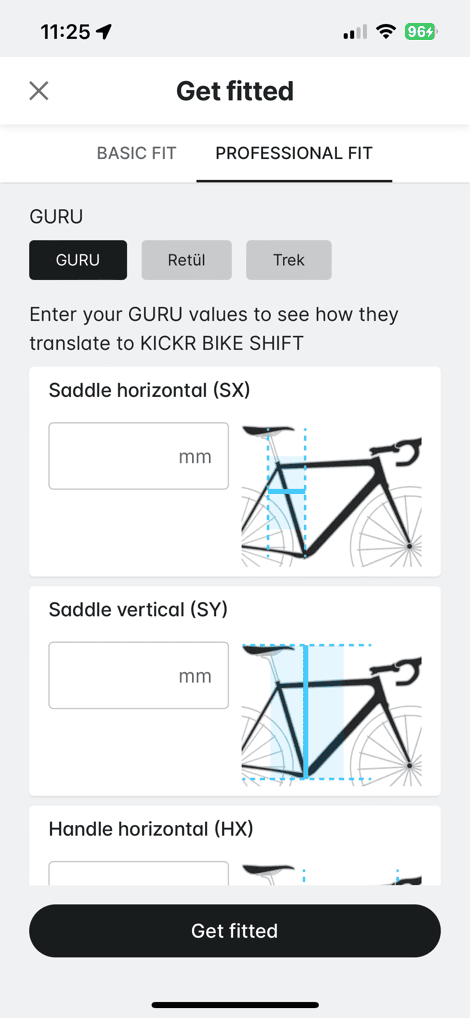
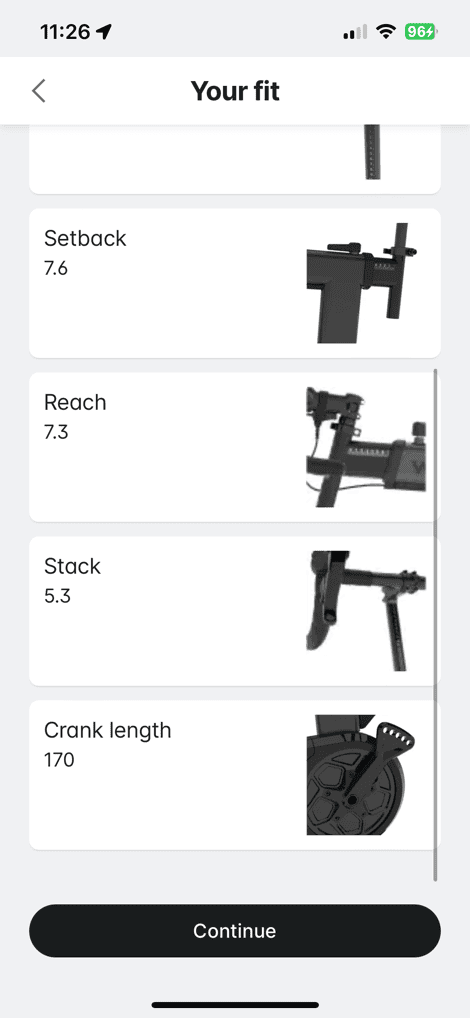
You’ll notice that the measurements it gives are both the numerals on the rulers next to each component of the bike, as well as the A/B/C/D/etc next to the standover height adjustment. Notably, the new Wahoo app seems to have done away with the ability to take a photo of your bike with your phone, and have it estimate the fit coordinates from the imagery.
One of my somewhat favorite fit aspects of the KICKR BIKE SHIFT is that the top-tube is much slimmer than past KICKR BIKEs. For many people, the width of the top-tube caused constant rubbing on your thighs, and was by far the largest (in width) top-tube of any indoor bike on the market near where your legs would rub (the Tacx Bike doesn’t have a top tube that goes across to rub against).
Next of note is crank length adjustment. Wahoo uses a bear-claw style system, which means you simply put your pedals in whichever crank length hole you want. They support 165/167.5/170/172.5/175mm crank lengths, and the app (as seen above), will also help you choose which crank arm length to use, if you aren’t familiar:
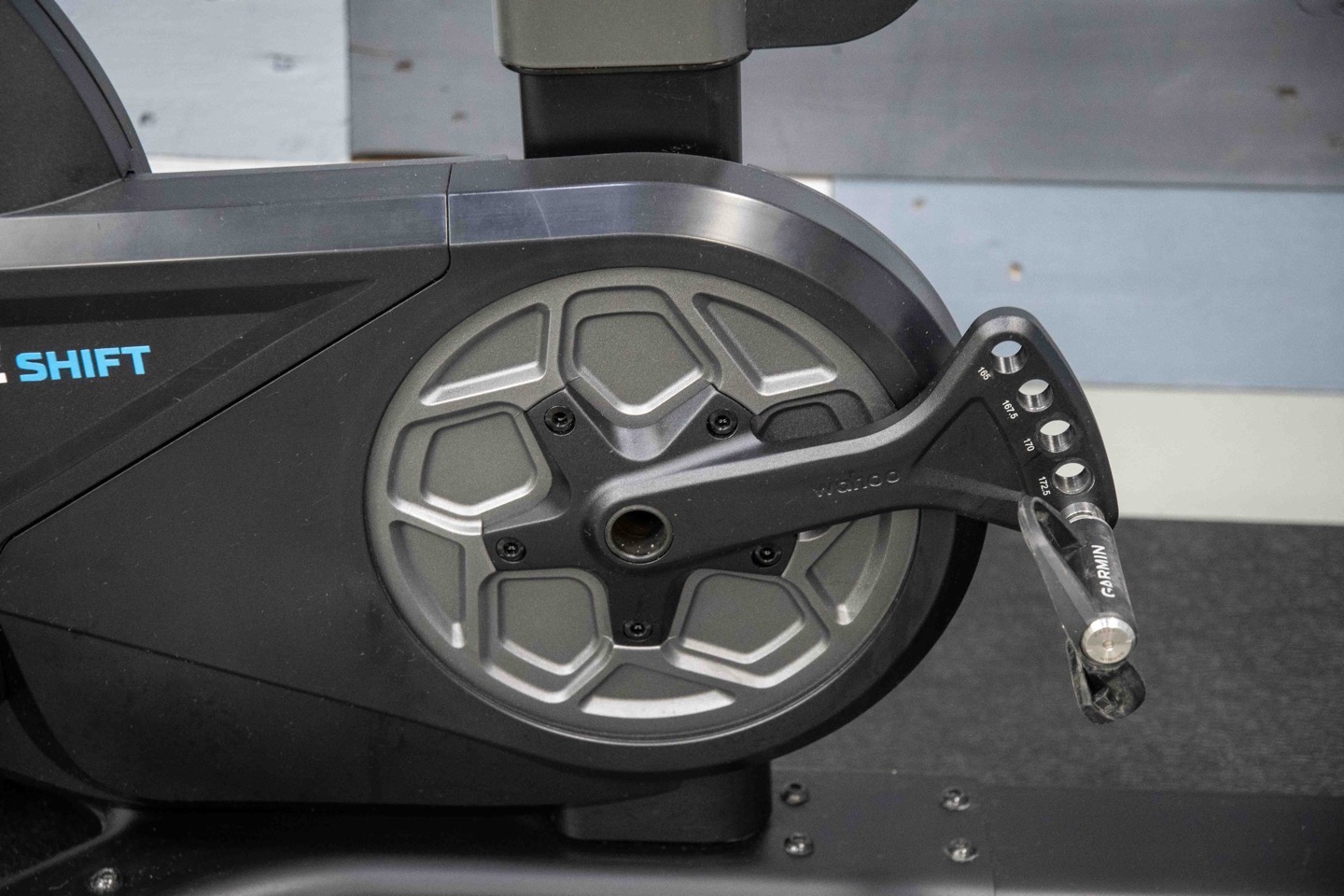
Notably on the KICKR Bike SHIFT, they simplified this design compared to their previous iterations which had more stylistic flare but probably weaker points, likely as a result of some breakage that was seen by a few people.
Lastly, as for triathletes, note that the KICKR BIKE SHIFT uses standard handlebars, thus, you can easily install clamp-on aero bars on this setup. I didn’t do it for the KICKR BIKE SHIFT, but do have them on my KICKR BIKE V1 at home, which looks like such when I first photographed it years ago:
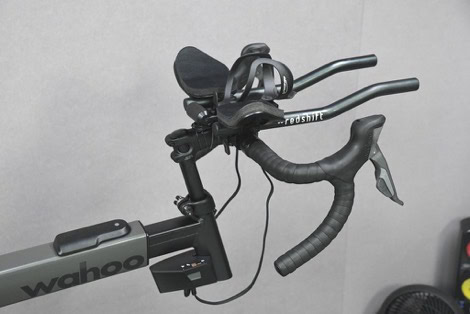
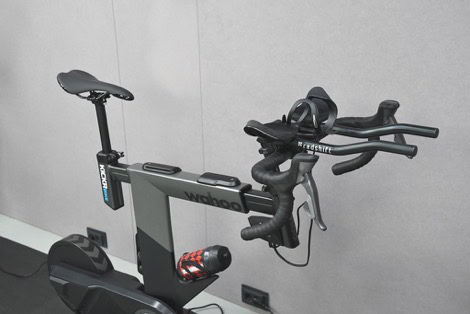
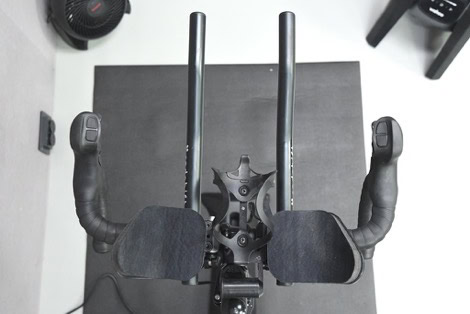
The only downside being there’s no remote shifters on the KICKR Bike (either unit), so any shifting will still need to be done at the handlebar shifters.
Riding It:

Let’s dive into riding it day to day. In this section I’m going to talk about more subjective things – such as road-like feel and movement. As well as some logistical basics, though for deeper technical aspects like protocols, see the App Compatibility section after this.
When it comes to pairing up to your favorite apps, the KICKR BIKE SHIFT does support all of them easily. Starting with the most popular, Zwift, you’ll pair it up first as a power source and resistance trainer, then cadence, then the ‘Steering’/Controls option, which allows you to steer within the game.
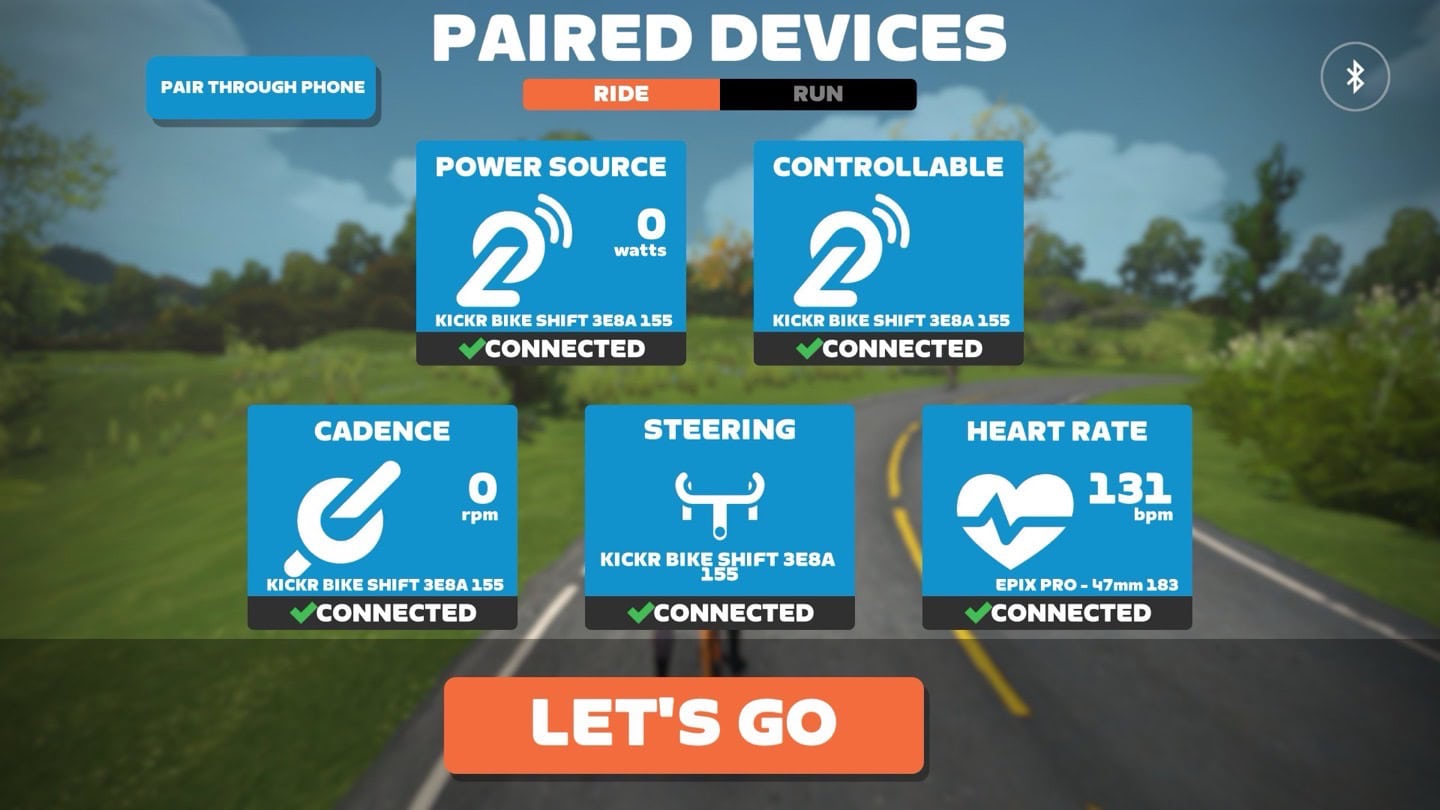
However, one thing you may want to briefly do is swing back to the Wahoo Fitness app, to set up your specific shifting preferences. The KICKR BIKE SHIFT allows you to customize the shifters to three different shifting types:
A) Sequential
B) Shimano (akin to Di2)
C) SRAM (akin to AXS/eTAP)
Within that, you can then create specific bike gearing profiles, choosing from common chainring/cassette combos, or creating your own (also, I have no idea why my “Life Odometer” reads 0km, instead of however many kilometers I’ve actually ridden):
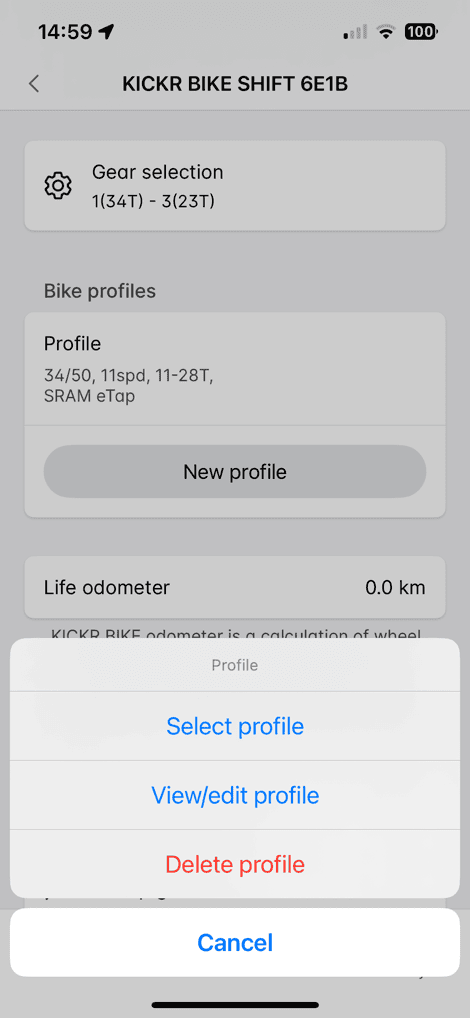
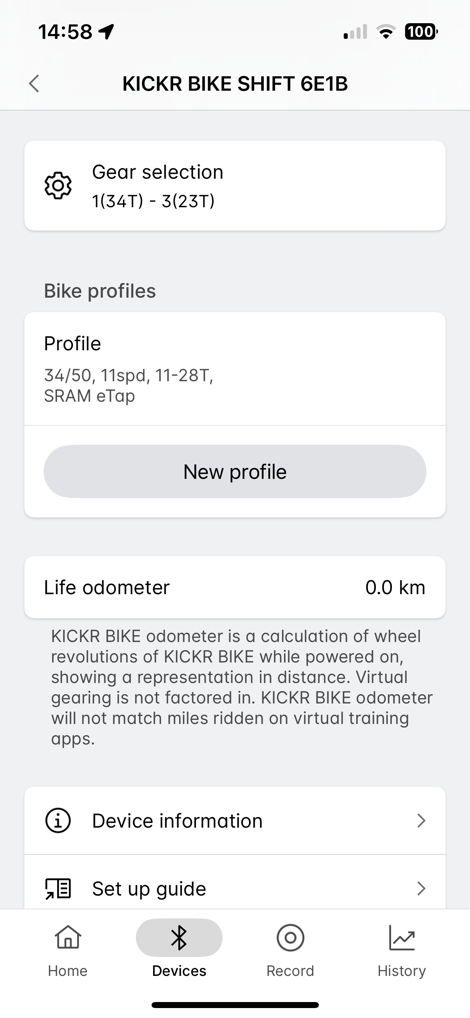
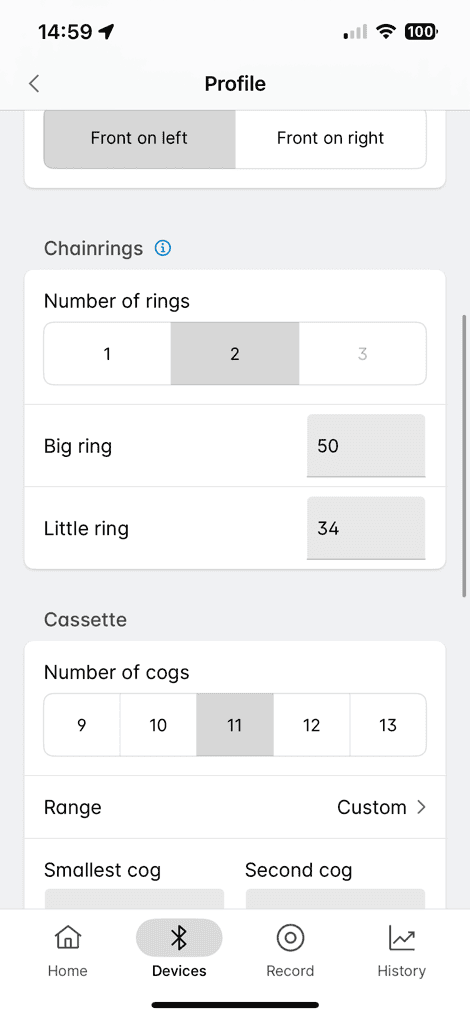
You can create multiple bike/rider profiles. Though, as has been the case since the beginning of KICKR Bikes, you’ll need to remember to switch these before you start riding in Zwift/etc. In an ideal world, Zwift and other apps would have this be a quick-select option in the game (or even tied to virtual bikes), getting rid of per-rider switching that must be done on the Wahoo app. In some ways, IndieVelo gets reasonably close to that, as I can tweak the shifting and the gearing a bit there:
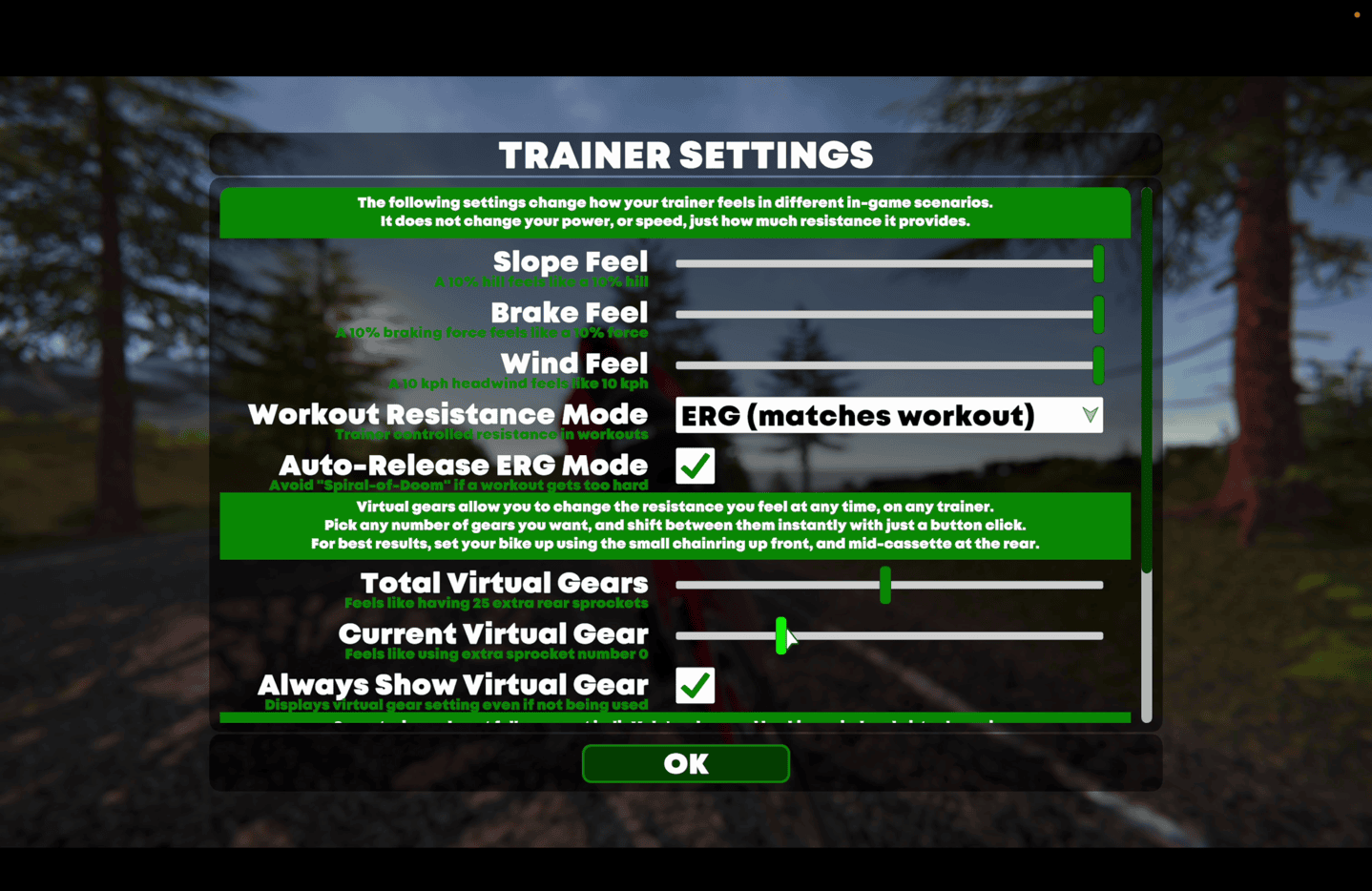
In any event, with that settled, you’ll go off and start pedaling in the game of your choice. Below is Zwift in simulation mode (called SIM mode), which is the mode used when it ‘simulates’ the gradient of a route (e.g. going up a 5% hill). In this case it’ll automatically make the trainer feel like a 5% hill, albeit that does depend on the ‘Trainer Difficulty’ setting you have in the app. By default Zwift is actually only 50% difficulty level, so it’ll feel more like a 2.5% hill instead of 5% if you don’t change it.
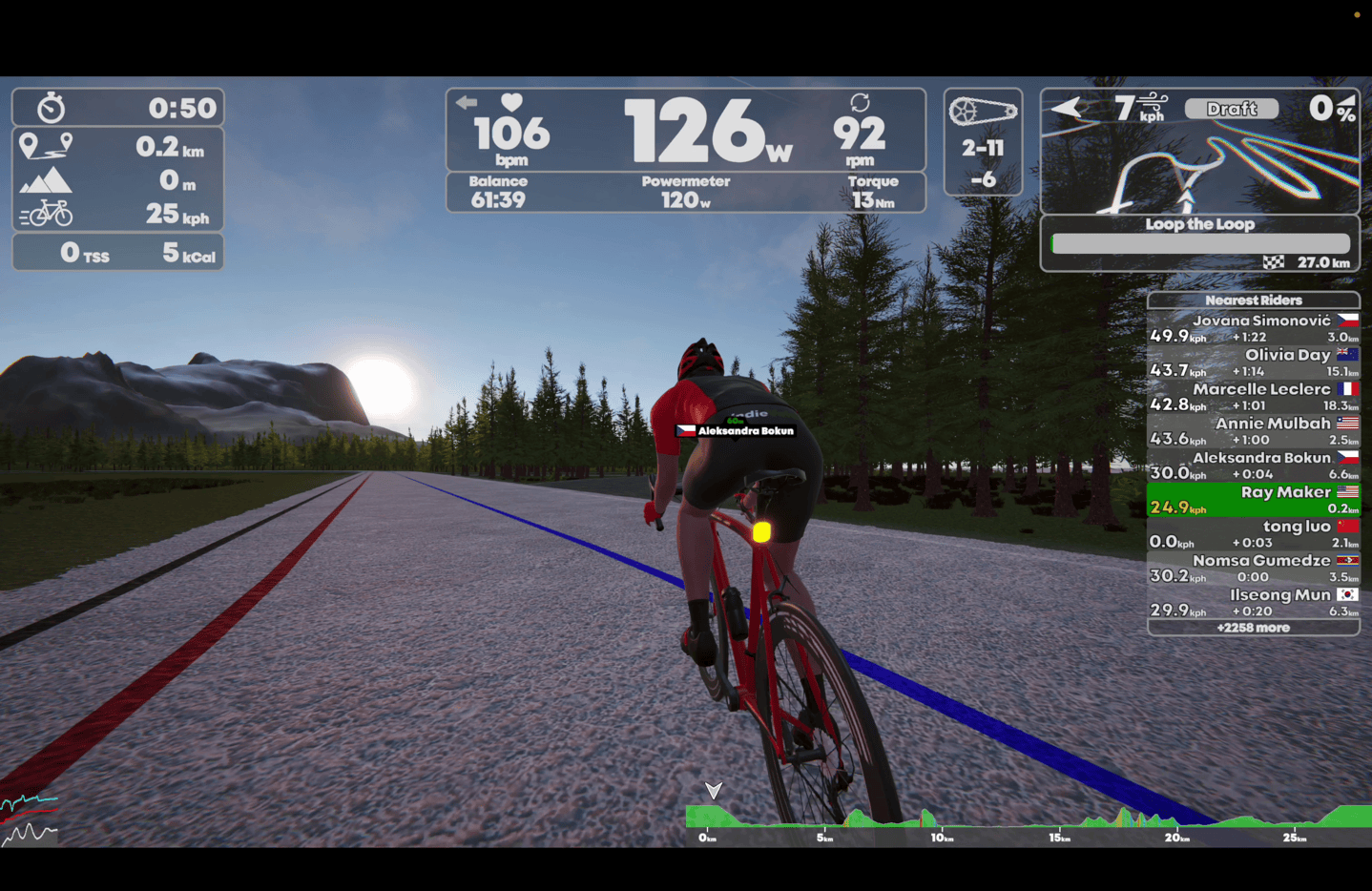
Unlike the KICKR BIKE V1 & V2, the SHIFT doesn’t physically move/tilt the bike up and down. Which, is totally fine. Having the bike go up/down as you go up/down hills is fun, but isn’t something I’ve actually used much on the KICKR BIKE V1 that I own. This is largely because I almost always forget to unlock the feature before each ride, and just totally forget about it. In talking with many KICKR Bike owners over the years, many fall into this same camp. Of course, some absolutely love it – to each their own!
Next, there’s the ‘road-like’ feel aspects. How does acceleration and deceleration feel? When you sprint, does it ‘feel’ real? In this case, yes, it feels good and real. That’s notable because it’s actually a very different technology than the KICKR BIKE V1 & V2. The KICKR Bike SHIFT is more akin to the Wahoo KICKR smart trainers, whereas the KICKR BIKE V1/V2 use an electromagnetic system (like a Tacx NEO series device). In most riding scenarios you won’t notice the difference. However, one area they are different is descending. In the KICKR Bike V1/V2, it’ll actually propel/motor the ‘wheel’ (flywheel) forward, so it’ll feel like you’re going downhill. Whereas in the SHIFT, if you stop pedaling, eventually the bike’s flywheel will stop, as if you were on flat ground.
Again, like the KICKR CLIMB up/down part, if you’ve never had that experience before, you won’t notice it missing. Whereas, if you have had it, you may or may not notice the lack of it. Totally depends on personal preference.
Of course, all of that described ‘SIM’ mode, whereas in ERG mode you’ve got structured workouts. In that case, the SHIFT is simply controlling the wattage per your structured workout. Here’s an example from Indievelo where it’s controlling the SHIFT. As always, there’ll be a slight variance second to second between what it sets, and how you pedal. But it’ll otherwise hold things well:
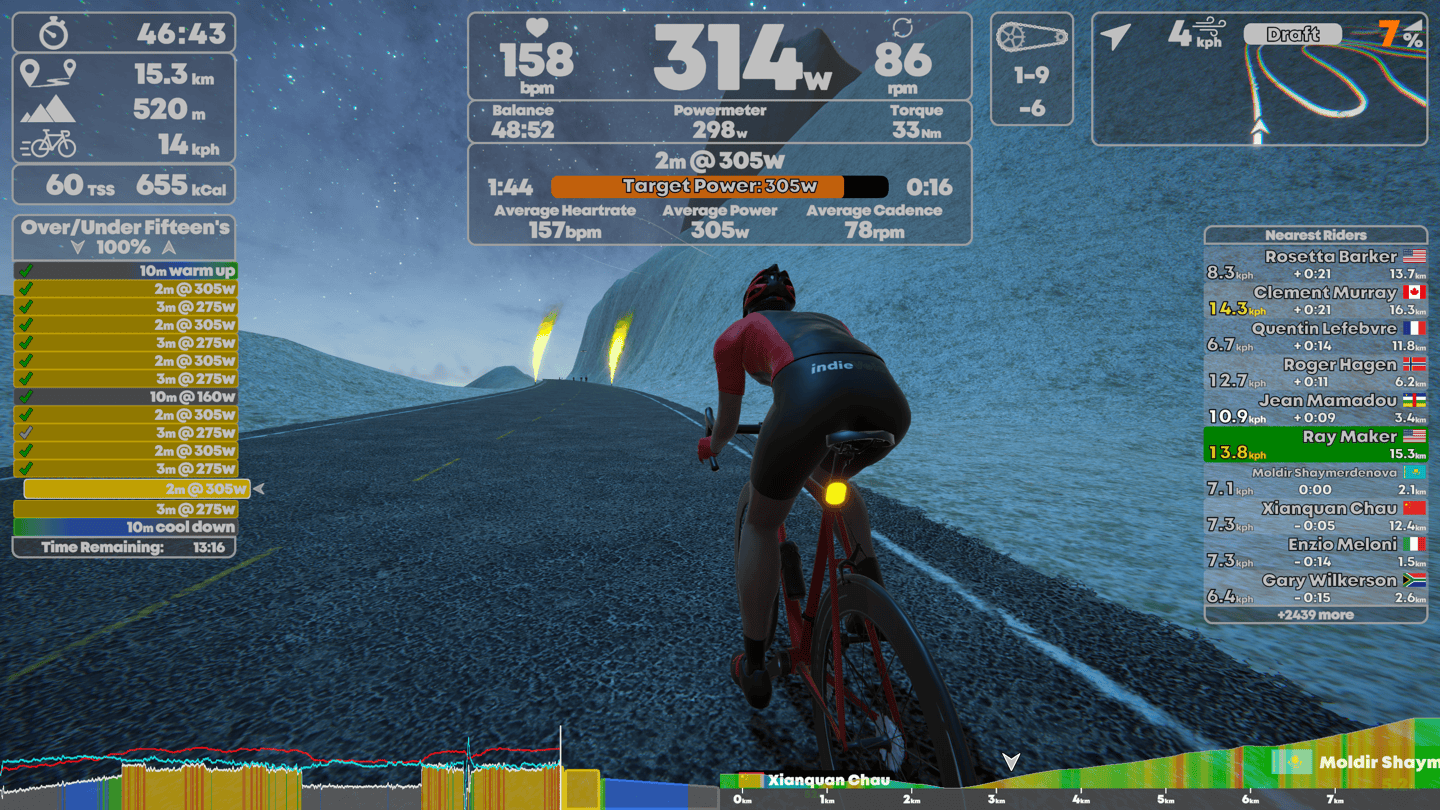
Speaking of things that spin – what about noise? It’s quiet. Which, is unlike the KICKR BIKE V1/V2, which will make all assortment of noises (especially as it ages). The V2 is definitely quieter than the V1, especially in the aging department. But both V1/V2 are louder than SHIFT. The SHIFT is essentially silent. Here’s a quick noise test I did previously:

Now, circling back to shifting and breaking, I really like the KICKR BIKE SHIFT handlebars/shifters. Specifically, I like the fact that they feel like real shifters, not just some gamified buttons. I think that’s super important in a smart bike. After all, if I wanted simple buttons, I’d play a video game on the couch. Instead, I want to feel like I’m riding a bike. And the KICKR BIKE SHIFT nails that:
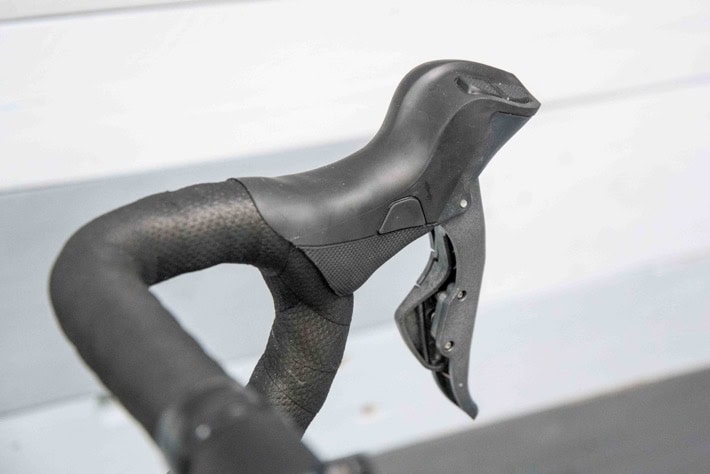
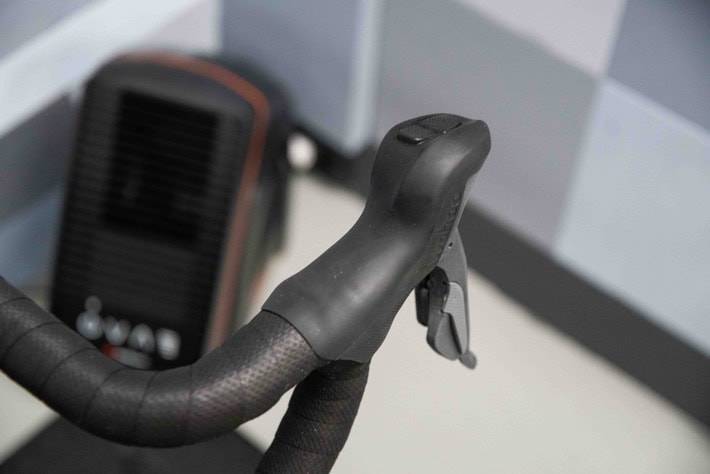
You feel the ‘click’ of a shift, just like on real handlebars/bikes. And as noted earlier, you can recreate both Shimano and SRAM style shifting. Likewise, you can also brake using the brakes on the front, which slows your avatar in most games. Honestly, I have no reason to make my person go any slower, I’m already slow enough as it is.
To steer within games that support steering, you’ll use the two ‘inner’ buttons, seen on the inside of each shifter. This will move you across the designated lanes within that game, depending on how the given game is coded to support steering commands.
Lastly, what about movement and feel? Certainly, this bike lacks any sort of rocker-plate type functionality. So you’re not going to get as much movement as you would on something like the KICKR MOVE smart trainer, or sticking the whole thing on a rocker plate. But given the frame design, you do get a bit of sway out of it. I’d classify it as ‘perfectly fine’. Nothing amazing movement-wise to write home about, but nothing that bugs me either.
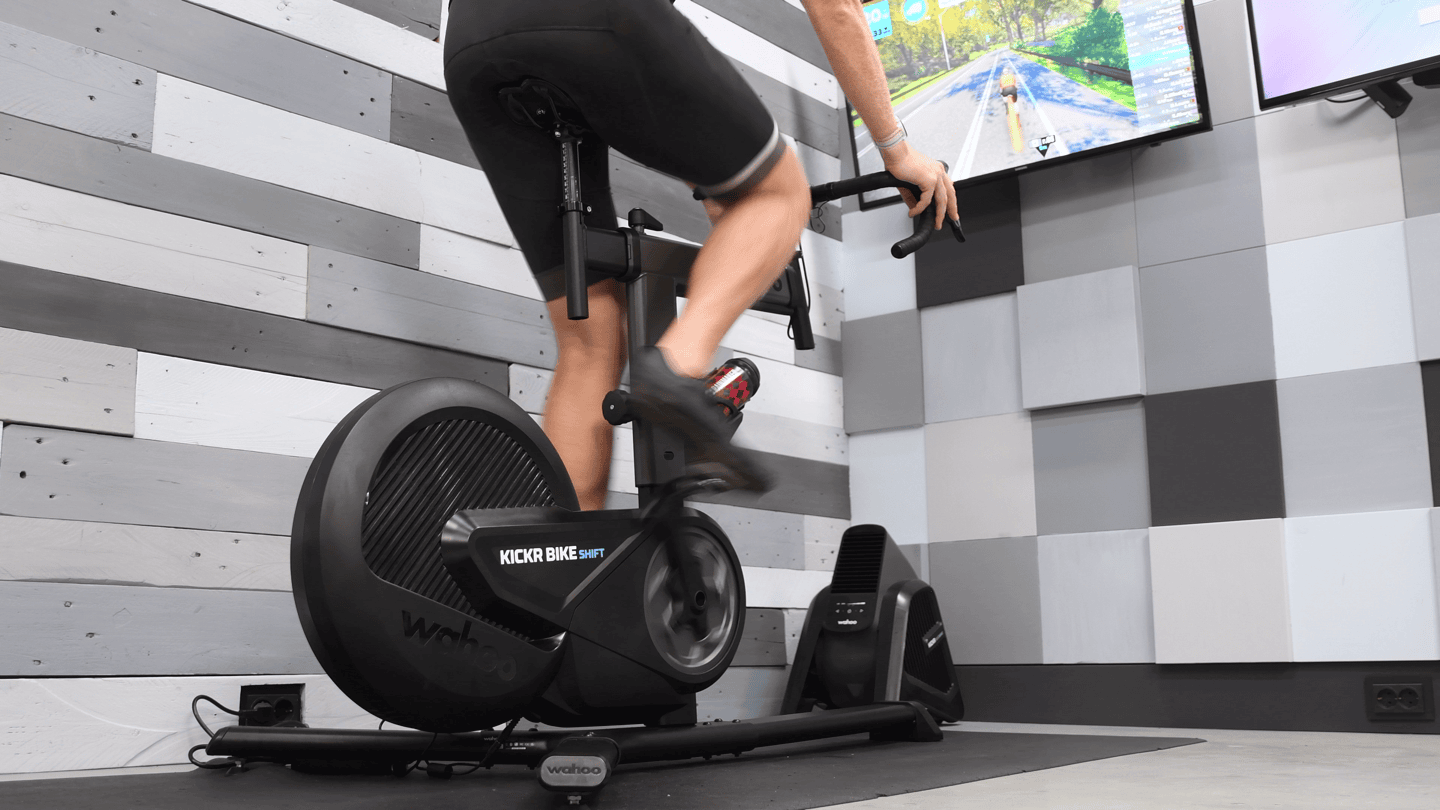
Likewise, on stability, as a tall dude, sometimes I see indoor bike/trainer designs that lend themselves more easily to tipping over. This isn’t one of those. I haven’t had any tipping/stability issues here. If you somehow manage to tip-over the KICKR Bike SHIFT, then you were likely doing some 50 Shades stuff with it. It’s not going anywhere with normal riding.
App Compatibility:
The Wahoo KICKR BIKE SHIFT follows pretty much all the same norms in terms of interoperability as other smart bikes, as well as virtually all smart trainers. As you probably know, apps like Zwift, TrainerRoad, Indievelo, Rouvy, FulGaz, Kinomap, and many more, all support most of these industry standards, making it easy to use whatever app you’d like. If trainers or apps don’t support these standards, then it makes it far more difficult for you as the end user.
To be specific, the KICKR BIKE SHIFT supports the following protocol transmission standards:
ANT+ FE-C Trainer Control: This is for controlling the KICKR BIKE SHIFT via ANT+ from apps and head units. Read tons about it here.
ANT+ Power Meter Broadcast: This broadcasts the KICKR BIKE SHIFT as an ANT+ power meter. This is handy for connecting your watch/bike computer to the KICKR BIKE SHIFT to record the data, without trying to control the resistance components. It’s how I record all of the data for accuracy tests.
Bluetooth Smart FTMS: This is used for controlling the KICKR BIKE SHIFT via Bluetooth from apps, like Zwift and more.
Bluetooth Smart Power Meter Broadcast: This broadcasts the KICKR BIKE SHIFT as a Bluetooth power meter. This is primarily used for Bluetooth-only watches to access your power data, like an Apple Watch or Polar/Suunto watch.
WiFi Direct Connect: WiFi is built-in, and allows the KICKR BIKE SHIFT to directly connect to WiFI for both game connectivity (effectively channeling your power meter/cadence/control over WiFi), as well as checking for daily firmware updates.
Ethernet Direct Connect (with adapter): This lets you buy Wahoo’s ethernet adapter, which connects on the back of the bike, to then plug into the network for wired connectivity for power meter/cadence/control.
The Wahoo KICKR BIKE SHIFT includes cadence data for any of the connections, so that data is baked into the power meter and trainer control streams. When you go to pair an app to the KICKR BIKE SHIFT you’ll see the cadence channel shown as well:

It’s these same standards that also allow you to connect via head units too. For example, the Wahoo bike computers as well as Garmin bike computers that have ANT+ FE-C for trainer control (or Wahoo Bluetooth Smart trainer control), so you can re-ride outdoor rides straight from your bike head unit to your trainer. Though realistically, very few people do that, given how good most apps are these days.
For me, in my testing, I used Zwift, IndieVelo, and TrainerRoad as my three main apps during my testing period. For both Zwift and IndieVelo, I used it with both SIM (simulates the ups/downs of a route), and ERG (structured workout mode). With TrainerRoad, there’s only ERG mode. Here you can see it paired up in IndieVelo:
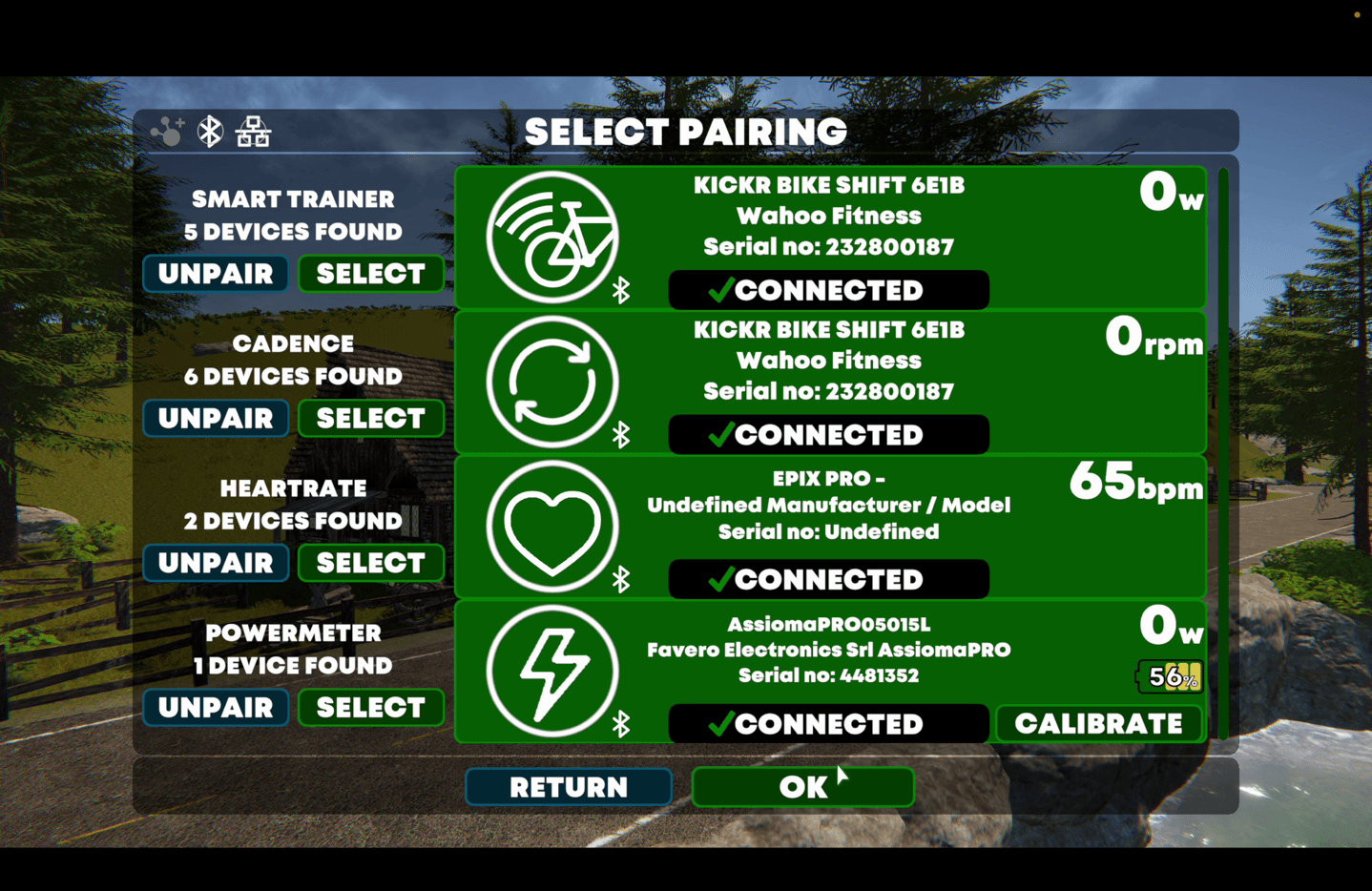
What’s cool here is that in IndieVelo, it does actually show shifting properly, whereas Zwift does not (as discussed earlier). Both shift just fine, but only IndieVelo is showing your current gearing.
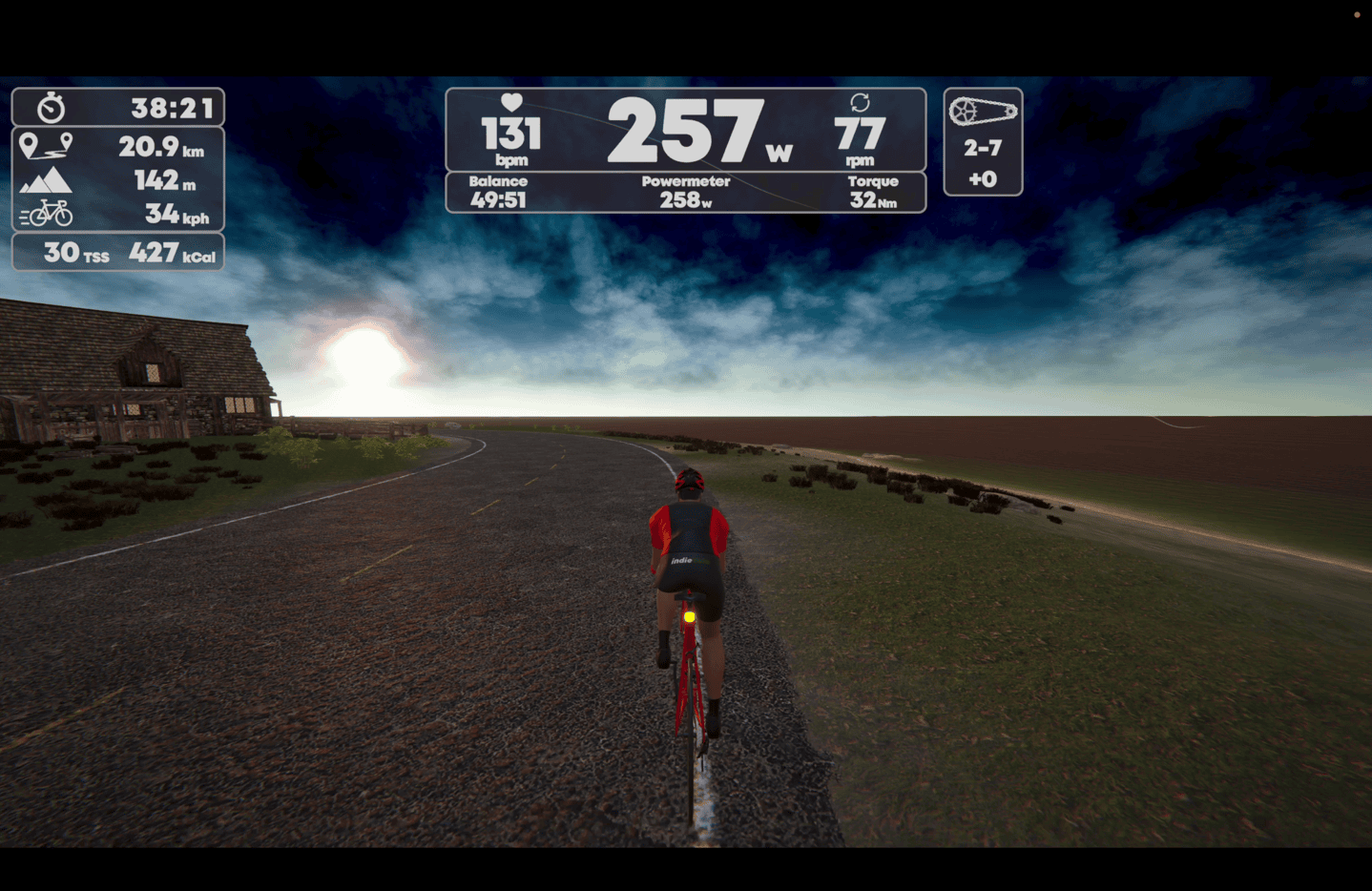
Meanwhile, in Zwift, everything works fine – including shifting and steering, but you just don’t yet get the gear display you would in IndieVelo. Of course in ERG mode, like below, gear display isn’t necessary:

I had no problems in either app from a compatibility standpoint in SIM mode, and likewise, also had no problems with TrainerRoad in ERG mode, which you can see here:

Now, it is worth noting that from time to time I also used the Zwift Play buttons, which worked perfectly fine for me, attached to the KICKR BIKE SHIFT. For those not familiar, these allow you quick access to various Zwift functions. I suppose in an ideal world, Zwift and Wahoo would work together to either integrate this type of stuff, or allow better usage of Wahoo’s existing handlebar buttons for added controls.
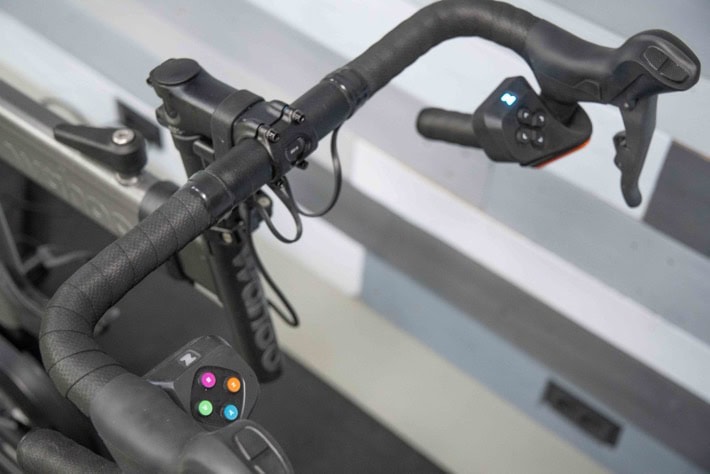
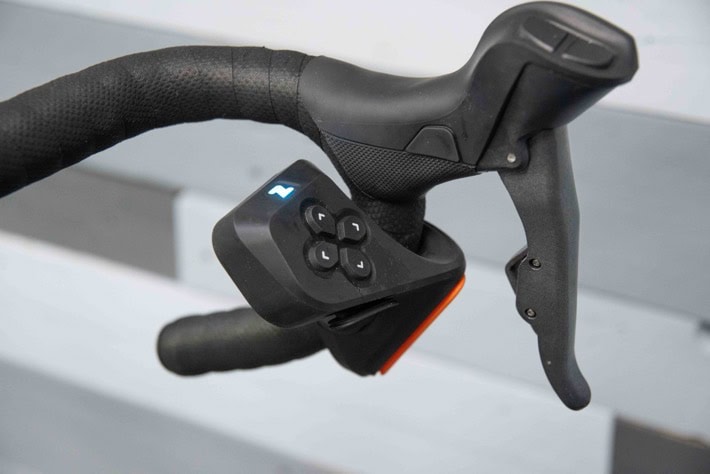
Still, if you’re looking to leverage the Zwift Play in your setup, this all works perfectly fine.
Power Accuracy:
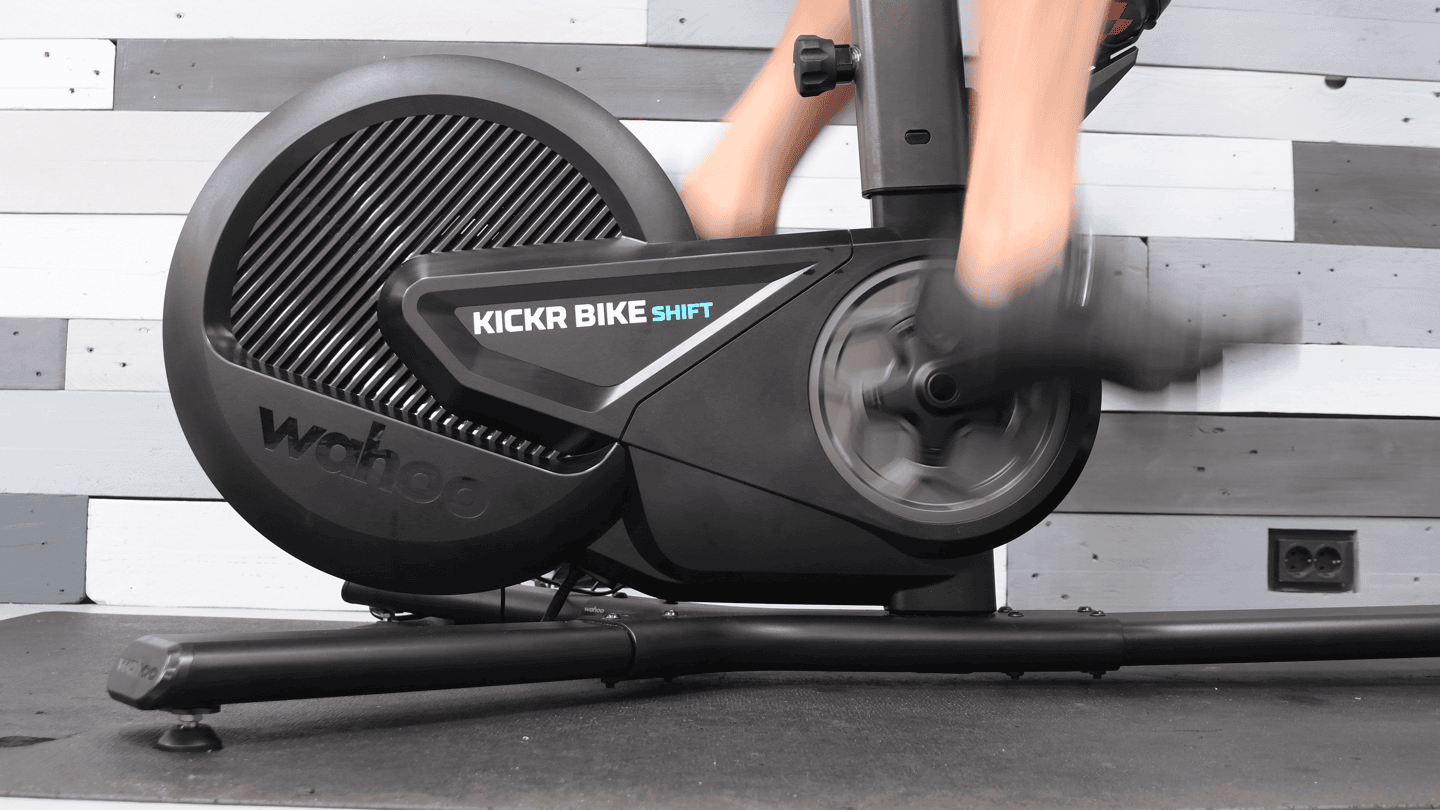
The whole reason this review is 9 months later is due to accuracy. Or rather, back at launch – inaccuracy. Initially it was due to a software bug that basically reset portions of the temperature compensation on my unit each time it updated the firmware (to a useless value). Thus I’d get one good ride, then one bad ride, and back and forth. Following that, for a month or so, it was just random bad-accuracy days. Eventually, I put it aside to deal with other products, and when I came back to it (a few firmware updates later), things were smooth sailing from then on out.
Thus, to spoil this section: It’s been good since mid-late November.
In any case, the goal here being that I’m comparing the KICKR BIKE SHIFT to a variety of known-good power meters, and testing everything from resistance control accuracy, to speed of change, to any other weird quirks along the way.
First up, let’s look at responsiveness. That isn’t directly accuracy, but we’ll get to that in a second. This piece looks at how fast the trainer responds to a given structured workout command (e.g. ‘350w’), and whether it’s within the acceptable range. Typically speaking, we want most trainers or smart bikes to get to a set point in about 2-4 seconds. We actually don’t want it to be 0 seconds, or even 1 second – as that’s like riding into a brick wall (such as going from 100w to 450w). Inversely, if it’s too long, it’ll cut into the benefit of certain types of intervals, such as micro-intervals.
For that, for virtually every trainer/bike I test, I do a series of 30×30 tests. In this case, this test is on TrainerRoad, and we’re going to look at exactly how long it takes to reach the set-point and stabilize:

And that’s the other important piece: The wattage has to stabilize. We don’t want it to reach the 450w, and then blow through it and make you do 500w instead for the first 3-5 seconds. It needs to stick the landing.
Here we can see that it does stick that landing in 3 seconds each time. You’ll see some variability below, because I had done a longer trainer ride just before this one, so my legs were a tiny bit tired. Nonetheless, three seconds into each interval and it’s within 1w of the set point, and even the ‘above/below’ parts are only 10w out.

So then we look at the accuracy compared to other known-good power meters. In this case we’ve got a pair of Favero Assioma Duo’s (Shimano variant), to compare to, and you can see it’s within a few watts:

It’s a little bit easier to see, when I zoom in:

So, with that initial baseline established, let’s fast-forward to a longer ERG workout that I did last week, another slate of 30×30’s. In this case, you can see just how incredibly tight these are, compared to the Favero Assioma MX2 Pro pedals. Here’s that data set:
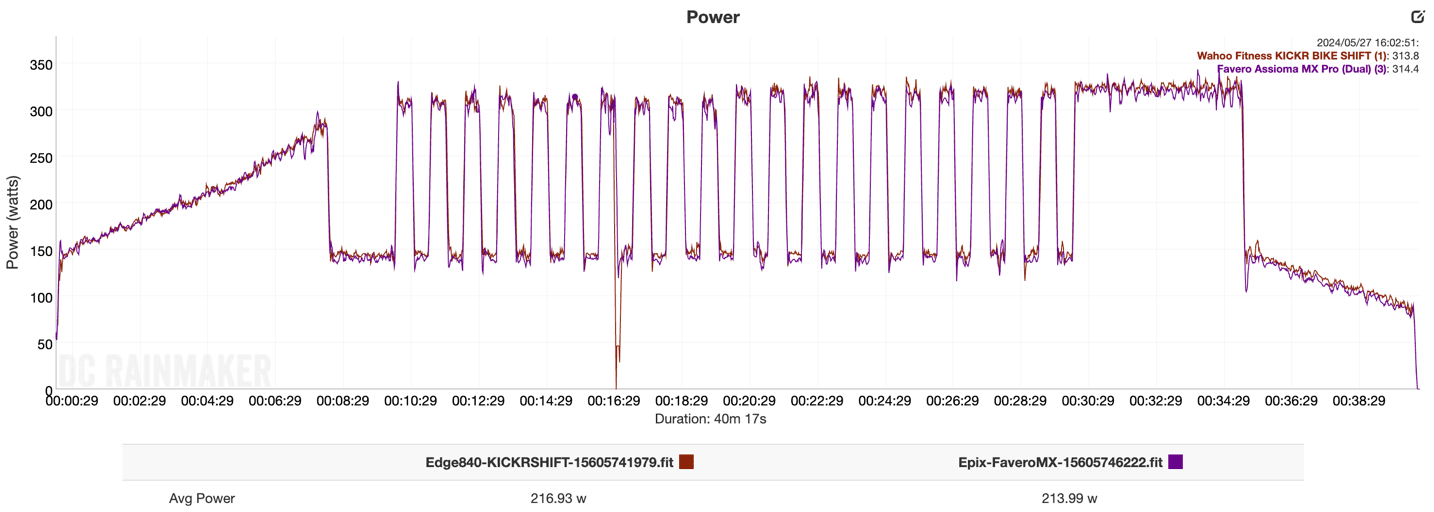
If you zoom in, you’ll see most of the time it’s within 1-3w:

Likewise, cadence is virtually identical. However, the scale here will throw you off (as well multi-second averaging on this graph):

Finally, check out the mean-max graph. Again, the scale here is really important to look at. These are an astonishing 3w difference across some of these chunks:

Ok, moving onto some SIM mode stuff, this time an Indievelo workout on rolling terrain. Here’s that data set:
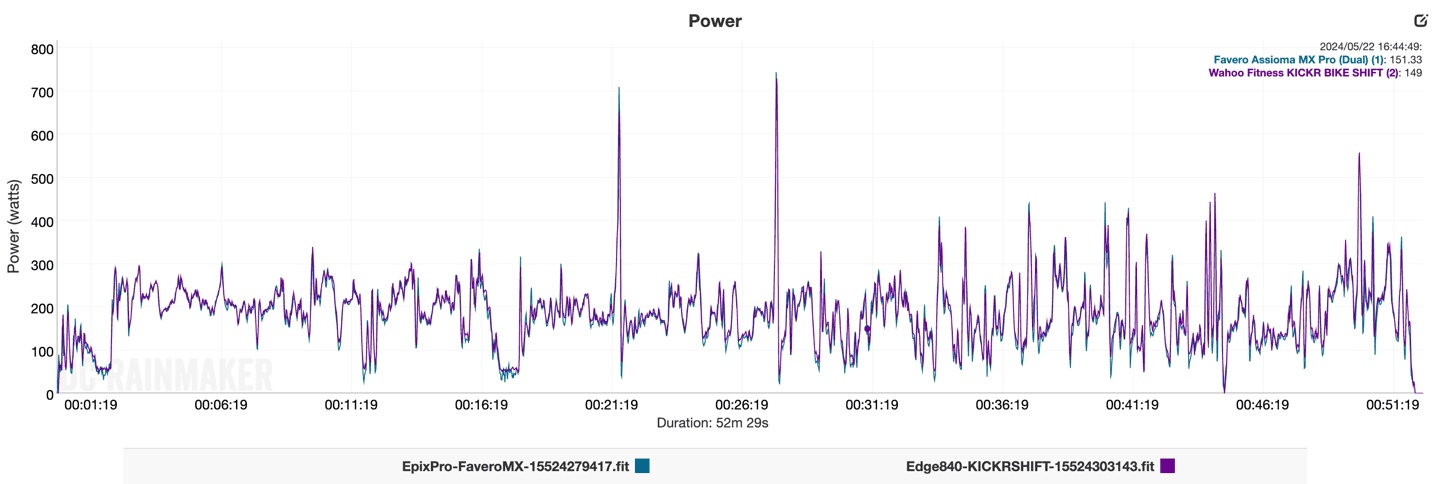
If we zoom into the sprints, we do see some slight differences at the absolute peak 1-second powers. In some cases, like this first screenshot, the Favero MX pedals are higher than the Wahoo SHIFT:

Yet in this case, on these surges, the SHIFT is higher than the Favero pedals:

In looking at many different scenarios, I haven’t seen a super-clear pattern as to why/when one is higher than the other.
In any case, cadence looks good:
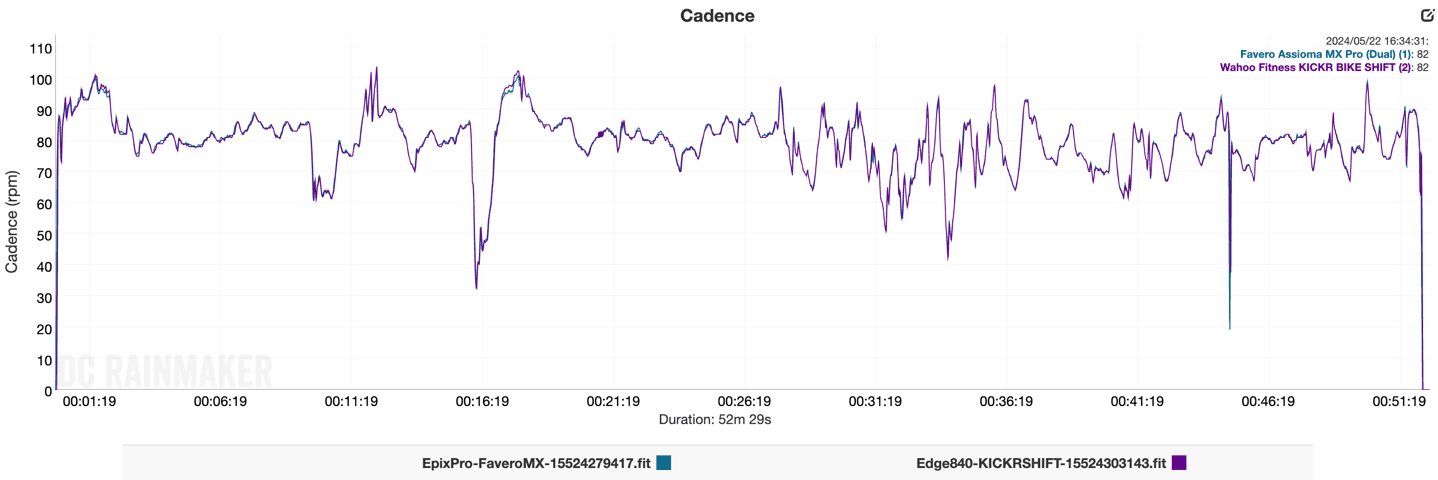
As does the again incredibly close mean-max graph:

Here’s another simulation mode workout, with some sprints towards the end:

These surges/sprints (shown with 3-second averaging), look very close, within a few watts – which is tricky to do at this power level, due to variations in transmission/recording timing:
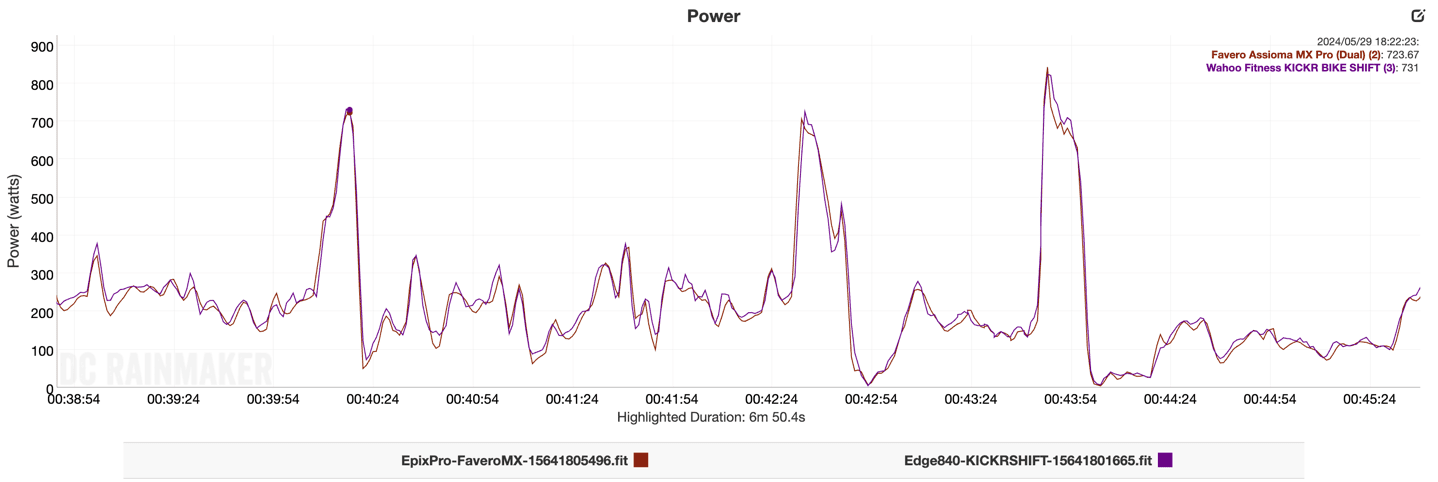
Likewise, cadence looks good too:
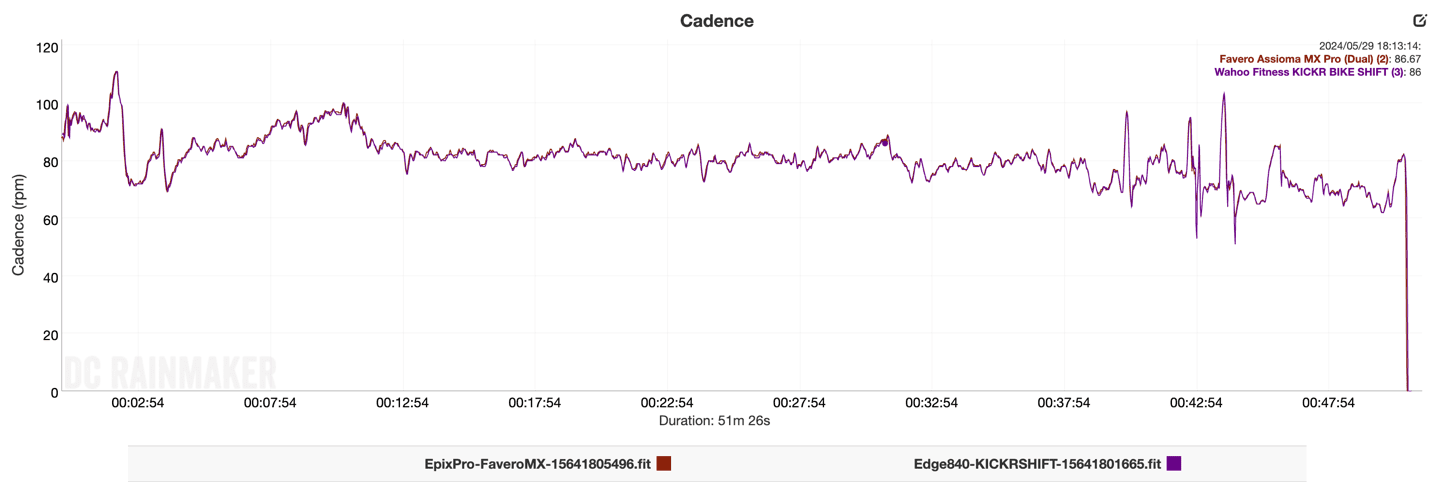
And again, so does Mean/Max:

Ultimately, while things started out (very rough) for my KICKR BIKE SHIFT last fall (as noted in my initial preview), with a few software updates, they’ve seemingly worked out any early teething kinks of the resistance unit.
At this point, in terms of responsiveness, accuracy, and stability, I don’t see any issues with the KICKR BIKE SHIFT, when compared to numerous known-good and trusted power meter pedals.
Indoor Bike Comparison:
Here’s the KICKR Bike SHIFT added to the product comparison database. In this case, I’ve put it up against the Wahoo KICKR Bike V2, the Tacx NEO Bike Plus, and Wattbike ATOM 2020. Of course, with Stages Cycling now out of business, I’d normally have added in the Stages SB20 in there somewhere. But…yeah. As a rule of thumb, I don’t put products in the product comparison database unless I’ve had hands-on/riding time with it. Thus, things like the newer Decathlon indoor bike isn’t in here yet.
| Function/Feature | Wahoo KICKR BIKE SHIFT | Wahoo KICKR Bike V2 | Tacx NEO Bike Plus | Wattbike ATOM 2020 |
|---|---|---|---|---|
| Copyright DC Rainmaker - Updated June 12th, 2024 @ 8:07 pm New Window | ||||
| Price for trainer | $2,999 | $3,999 | $3,999 | $2,599 |
| Trainer Type | Indoor Bike | Indoor Bike | Indoor Bike | Indoor Bike |
| Available today (for sale) | Yes | Yes | Yes | Yes |
| Availability regions | Limited Initially | Limited Initially | Global | UK/South Africa/Australia/Scandinavia/USA |
| Wired or Wireless data transmission/control | Wireless | Wireless | Wireless | Wireless |
| Power cord required | Yes | Yes | No | Yes |
| Flywheel weight | 13bs/5.9kgs | Simulated/Virtual 125KG | 9.28KG/20.4lbs | Resistance | Wahoo KICKR BIKE SHIFT | Wahoo KICKR Bike V2 | Tacx NEO Bike Plus | Wattbike ATOM 2020 |
| Can electronically control resistance (i.e. 200w) | Yes | Yes | Yes | Yes |
| Includes motor to drive speed (simulate downhill) | No | Yes | Yes | No |
| Maximum wattage capability | 2,200w @ 40KPH | 2,200w @ 40KPH | 2,200w @ 40KPH | 2,500w |
| Maximum simulated hill incline | 20% (and -15% downhill) | 20% (and -15% downhill) | 25% | 25% | Features | Wahoo KICKR BIKE SHIFT | Wahoo KICKR Bike V2 | Tacx NEO Bike Plus | Wattbike ATOM 2020 |
| Ability to update unit firmware | Yes | Yes | Yes | Yes |
| Measures/Estimates Left/Right Power | No | No | Yes | Yes |
| Can directionally steer trainer (left/right) | Yes (with compatible apps) | Yes (with compatible apps) | YES (WITH COMPATIBLE APPS) | Yes (with compatible apps) |
| Can simulate road patterns/shaking (i.e. cobblestones) | No | No | Yes | No | Motion | Wahoo KICKR BIKE SHIFT | Wahoo KICKR Bike V2 | Tacx NEO Bike Plus | Wattbike ATOM 2020 |
| Whole-bike physical gradient simulation | No | Yes | No | No |
| Can slide forward/back with movement | No | No | No | No |
| Can rock/tilt side to side (significantly) | No | No | No | No | Accuracy | Wahoo KICKR BIKE SHIFT | Wahoo KICKR Bike V2 | Tacx NEO Bike Plus | Wattbike ATOM 2020 |
| Includes temperature compensation | Yes | Yes | N/A | Yes |
| Supported accuracy level | +/- 1% | +/- 1% | +/- 1% | +/- 2% | Trainer Control | Wahoo KICKR BIKE SHIFT | Wahoo KICKR Bike V2 | Tacx NEO Bike Plus | Wattbike ATOM 2020 |
| Allows 3rd party trainer control | Yes | Yes | Yes | Yes |
| Supports ANT+ FE-C (Trainer Control Standard) | Yes | Yes | Yes | Yes |
| Supports Bluetooth Smart FTMS (Trainer Control Standard) | Yes | Yes | Yes | Yes |
| WiFi or Ethernet | WiFi (Ethernet with accessory) | WIFI (ETHERNET WITH ACCESSORY) | No | No | Data Broadcast | Wahoo KICKR BIKE SHIFT | Wahoo KICKR Bike V2 | Tacx NEO Bike Plus | Wattbike ATOM 2020 |
| Transmits power via ANT+ | Yes | Yes | Yes | Yes |
| Transmits power via Bluetooth Smart | Yes | Yes | Yes | Yes |
| Supports Multiple Concurrent Bluetooth connections | Yes, 3 Concurrent | Yes, 3 Concurrent | No, just one | Yes |
| Transmits cadence data | Yes | Yes | Yes | Yes |
| Bridging or re-transmission | No | No | No | No |
| Race Mode (High Speed Data) | No | Yes (Beta) | No | Indoor Bike Features | Wahoo KICKR BIKE SHIFT | Wahoo KICKR Bike V2 | Tacx NEO Bike Plus | Wattbike ATOM 2020 |
| Shifting type | Normal bike levers | Normal bike levers | Normal Bike Levers | Buttons |
| Can customize shifting (Shimano/SRAM/Campagnolo) | Yes (Shimano/SRAM/Campagnolo) | Yes (Shimano/SRAM/Campagnolo) | Yes | No |
| Can customize gearing | Yes (both cassette and chainrings) | Yes (both cassette and chainrings) | Yes | Yes |
| Supported Crank Lengths | 165/167.5/170/172.5/175mm | 165/167.5/170/172.5/175mm | 170/172.5/175mm | 170mm |
| Display | No | Small display near top-tube | Yes | No |
| USB Ports | No | 1 USB port | 2 USB Ports (2AMP) | No | Purchase | Wahoo KICKR BIKE SHIFT | Wahoo KICKR Bike V2 | Tacx NEO Bike Plus | Wattbike ATOM 2020 |
| Amazon | Link | |||
| Backcountry.com | Link | |||
| Competitive Cyclist | Link | Link | Link | |
| REI | Link | DCRainmaker | Wahoo KICKR BIKE SHIFT | Wahoo KICKR Bike V2 | Tacx NEO Bike Plus | Wattbike ATOM 2020 |
| Review Link | Link | Link | Link | Link |
Expect me to add more bikes to this list in the near future, including the Mouv bike that’s been at the DCR Cave for the last few months.
Wrap-Up:
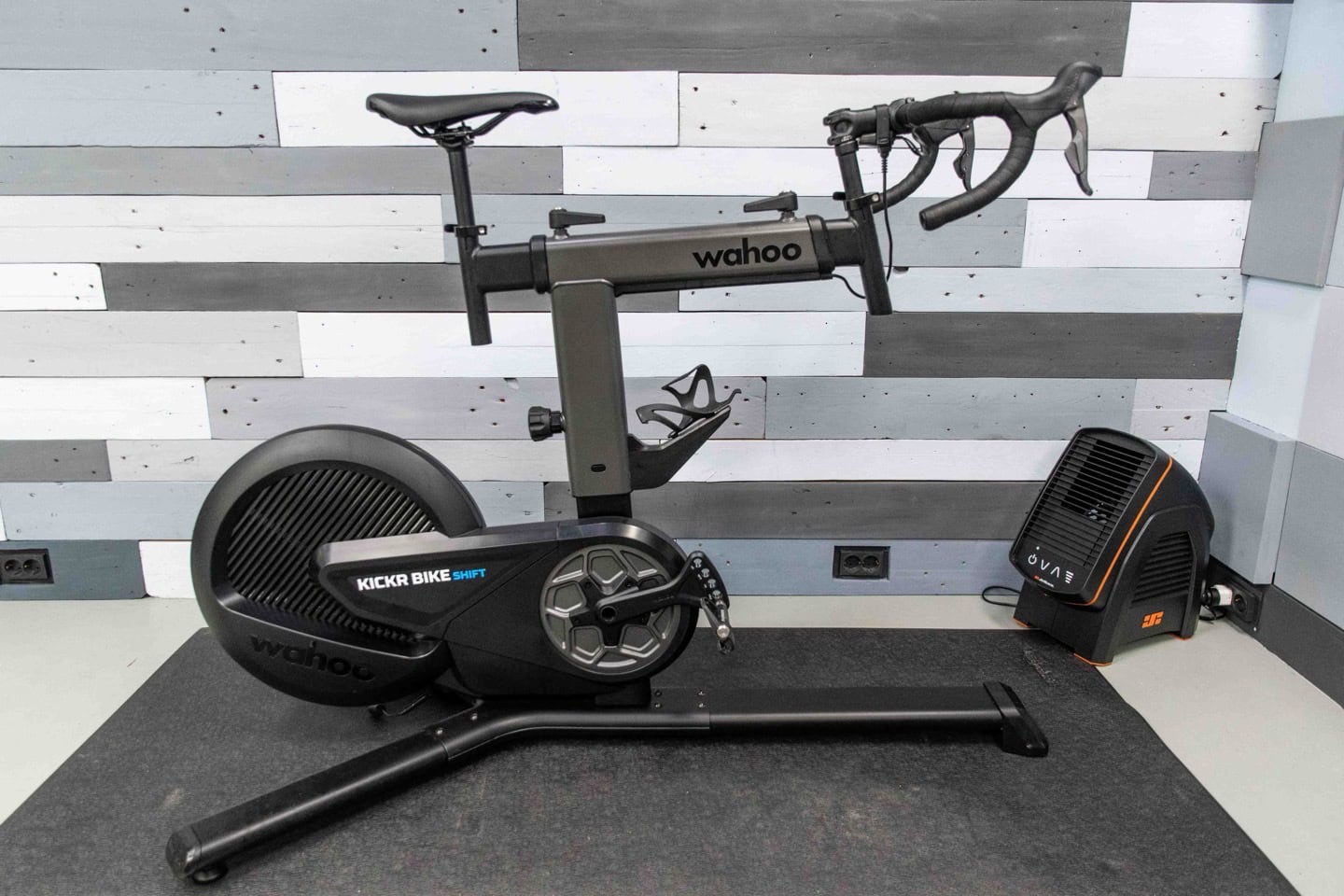
If you’re looking for an indoor bike, there’s plenty of options out there. Some great, some complete crap. And a bunch in the middle. The KICKR BIKE SHIFT is definitely in the great camp, just without the price tag of the higher-end full KICKR BIKE V2. While it lacks the physical up/down movement of the KICKR BIKE V2, it’s better in almost every other way. And as myself and many other KICKR BIKE owners have found over the last years, I rarely remember to unlock the up/down CLIMB portion of the KICKR Bike anyway. Thus, I’m not missing out on anything. Of course, it’s still a cool feature – but I personally wouldn’t pay that price difference at this point for just that feature. In the same way there will be a handful of people for which higher-speed data transmission of KICKR Race Mode will matter for.
Second, there’s just fewer things to break here. The KICKR BIKE V1 had plenty of physical hardware issues, as did most other V1 indoor smart bikes. Reality hit hard in this segment. The V2 bike has seemed to be much better on the hardware front, and by Wahoo’s own admission – most of the changes they made to V2 were aimed at reducing hardware issues. Likewise, most of the hardware changes made from KICKR BIKE V2 to to SHIFT were aimed at further eliminating hardware break points (e.g. anything that moved), as well as reducing the cost. The result seems quite solid.
Of course, with 9 months since the unit came out, I’ve been able to watch “The Internet” and their experiences with the SHIFT as well. On the whole, SHIFT buyers seem happy, but certainly there’s been a few people commenting with hardware-related failures. As always, it’s hard to figure out just how widespread it is, though, given how few comments relative to shipments there are, I think it’s definitely much better than the other Wahoo bike generations. However, I would agree with those that question why a $3,000 Wahoo smart bike (SHIFT) doesn’t have the KICKR Race Mode, yet a $1,200 Wahoo trainer does.
Nonetheless, if I were in the market for an indoor smart bike, the Wahoo KICKR BIKE SHIFT would definitely be in the running. But of course, there’s a lot of new entrants over the past year to consider. I’m sure at some point it’ll be time for a comparison post. With that – thanks for reading!
Found This Post Useful? Support The Site!
Hopefully you found this review/post useful. At the end of the day, I’m an athlete just like you looking for the most detail possible on a new purchase – so my review is written from the standpoint of how I used the device. The reviews generally take a lot of hours to put together, so it’s a fair bit of work (and labor of love). As you probably noticed by looking below, I also take time to answer all the questions posted in the comments – and there’s quite a bit of detail in there as well.
If you're shopping for the Wahoo KICKR BIKE SHIFT or any other accessory items, please consider using the affiliate links below! As an Amazon Associate I earn from qualifying purchases. It doesn’t cost you anything extra, but your purchases help support this website a lot.
Here's a few other variants or sibling products that are worth considering:
And finally, here’s a handy list of smart bike accessories that most folks getting a smart bike for the first time might not have already:
And of course – you can always sign-up to be a DCR Supporter! That gets you an ad-free DCR, access to the DCR Quarantine Corner video series packed with behind the scenes tidbits...and it also makes you awesome. And being awesome is what it’s all about!
Thanks for reading! And as always, feel free to post comments or questions in the comments section below, I’ll be happy to try and answer them as quickly as possible. And lastly, if you felt this review was useful – I always appreciate feedback in the comments below. Thanks!


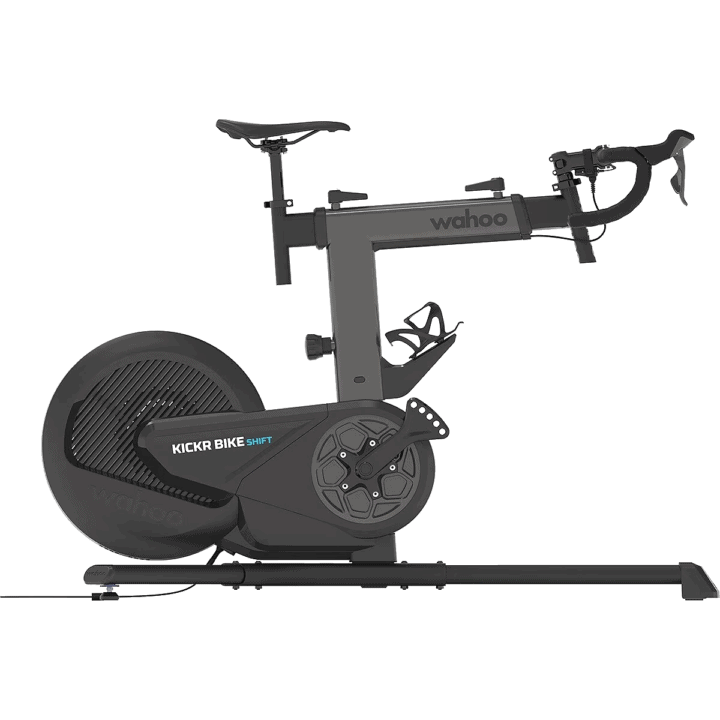
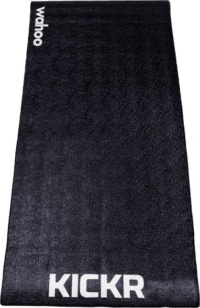
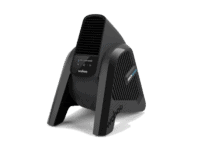




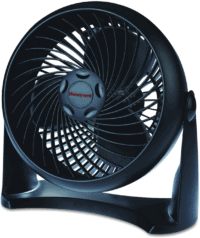
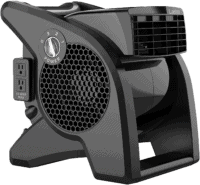

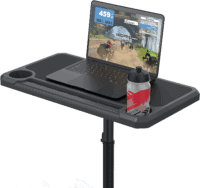





















Ray,
Slight typo “Now, not is worth nothing that from time to time” – I’m assuming this should have been “Now, it is worth noting that from time to time”
Cheers,
Matthew
I’m happy that Wahoo has stuck the landing on the Shift, but as somebody that is eying the Run, it makes me nervous for the function and longevity of a gen 1 product from Wahoo.
On my second unit (warranty replacement) and still have resistance drops when going uphill in Zwift. I could reach out to them again but considering it took months to get the second unit I’m reluctant. I can’t recommend this unit to anyone who isn’t a strong rider since I think my ability to put out wattage is nothing compared to Ray or Des and I think that’s a contributing factor in the drops.
Includes motor to drive downhill speed – should be ”no” on feature chart?
Thanks!
Thanks as always for the terrific review. I’ve had mine since November without issue. For this urban condo dweller, the combination of silence and a very small footprint made it a great option. It really is freakily quiet.
I did swap seats and added a second layer of bar tape because I found the bar itself too thin. That’s a bit disappointing for a $3K purchase, but such is life. And carbon paste solved a seat slippage issue, which I guess means I weigh more than Ray’s goat and cow. Ouch. Though I am glad to hear Ray has embraced Dutch boer culture.
Tom
Mouv bike, 6000 euro 😮
But thanks for this review as always
I mean, it does look beautiful, apparently has side-to-side tilting and they even offer a “triathlon” model (though I wonder whether it was necessary compared to making the frame more adjustable in the first place). But yes, the price is crazy – and it doesn’t even include shipping costs (200 on top, I guess?)
Hi Ray,
what’s the bike fan that’s in almost all of the KICKR SHIFT photos? It’s definitely not the one from the suggested products below the review.
And out of curiosity – is the KICKR Shift supplied with a saddle or do you need to provide your own? I assume it’s the former (for user convenience) which means that for a lot of people it would be one more piece of junk (as they’ve already settled on a specific saddle model).
There are several fans shown in those pictures. One is the standard Wahoo Fitness Headwind fan. The other one seen tucked into the back left corner is an unnamed fan, perhaps waiting for review by Ray.
The other fan pictured is the JetBlack “Trainer Fan” (yes, that’s the official name).
link to jetblackcycling.com
Overall I am very happy with the SHIFT.
Only unresolved things for me :
– My watch Garmin Forerunner 955 can only pair to the trainer and the power meter through ANT+, I would have preferred to use Bluetooth (getting more data points / seconds) but it seems Bluetooth only works with computers or smartphone for apps (Zwift etc…)
– The trainer, through the Wahoo app configuration won’t connect to my 2.4Ghz Wifi, I tried the main one from my router, the one from my smartphone wifi hot spot, and the one from another router I had. I finally bought the KICKR Direct Connect, it’s better anyway.
Those aren’t really issues anyway but if you solved those I would be happy to hear how.
Great review, thank you very much!
Still think $3k is too much but considering that I ride the bike indoors way more often than outdoors it might be worth it. Especially if the Shift is that quiet which means I could use it in the evening while my wife is watching TV.
One question: you mentioned the lack of shifting option on your Kickr Bike with aero bars. Would you be able to use the Zwift Click instead?
Yes, the price is the big problem for me as well. At $2k USD I’d have no hesitation, and at $2.5k (like the Wattbike) it would be tempting. I do almost all my riding indoors (other than Saturdays) and I’d definitely use it a ton, but at that price point I could set up three entire trainer stations or get a solid outdoor bike that could also be used on a trainer.
How do I get Zwift to look like Ray’s?
I’m thinking you probably look at the IndieVelo screenshot and not Zwift.
Honestly this looks perfect. I have a V1. If/when it fails I’d go for the shift over a V2.
Am I the only one that thinks that the KICKR SHIFT has forward and backward movements because of the “shift” name?
Great review Ray! As someone that has been thinking of getting an indoor bike for training this is quite timely.
Pardon a newbie question, but why choose an indoor bike for home use over a smart trainer? Seems like the smart trainer will be smaller and (much) cheaper, once you overcome the requirement that you either use your usual bike or find a beater to use with the trainer. Is it that the indoor bike avoids taking the bike on and off the trainer if you’re a frequent user, and perhaps is quieter?
Sweat and grease.. if you ride a lot, your outdoor bike will start to corrode (more than you might imagine) and also you still need to take care of the drivetrain, which can be a bit messy inside your living room. Also, it’s just nice, if the bike is simply there and always ready.
If you have a spare outdoor bike and/or a garage/dedicated fitness room, the smart trainer option might be better (and definitely cheaper), though. Ultimately a question of personal preferences and budget!
Thanks for the review. I keep on wondering what I’ll do if/when my V1 fails. It’s now long out of warranty, yet works great (*knock*). I only use it for Trainerroad/Zwift, but never use the tilt feature. It feels like the Kickr/V2 are oddly positioned in some ways, with each of them doing some things better than the other.
Wait, so there is crank length adjustment, but no handlebar width adjustment? That would have seemed to me like a low hanging fruit, it’s a stationary bike after all, something adjustable fitkit style, why not?
fyi: In the Indoor Bike Comparison table, `(EDIT)` text (does nothing, links to the same page) is visible when logged in as subscriber.
As a smaller rider (5′ 5″, 120 lbs) who’s FTP is quite low (156), I’m curious about the ride. Any chance your wife has taken the SHIFT for a spin? Would love to hear her thoughts.
Great review Ray, like always, thank you.
Any restrictions on max. cadence?
How tedious is it in real life to regularly change the adjustments between riders? Let’s say on a daily basis. Will I e.g. quickly get annoyed and the knobs will wear out or is it a 2min thing / no hassle at all?
These handlebars look really wide, they must be 42cm wide at least.
Is there an option to swap them for narrower bars?
We have 36cm bars in all bikes in our family… 42 just seems instantly invonvinient
You can swap for your preferred 31.8mm clamp handlebar.
420mm is the size spec’d on the majority of 54-56cm road bikes sold, which hits the center & largest distribution of rider size drom all i hvae seen. For those on either end of that bell curve, or have a different preference, they can change as needed.
Again… avoid this shit or wait for new revision. Mine has been replaced 4 times and each unit had some issues – starting from the weird knocking noise coming from the flywheel, to grinding noise around crank arms and overall build quality (problems to assembly handlebar, misaligned frame with the base, uneven handlebar).
You can check all the videos of my issues on YT – link to youtube.com as I had to record each of them when I was reporting every warranty claim to Wahoo. Of course everytime I was receiving new unit but same same story again. Finally I returned it and get full refund…
I have been following you for a long time, and I really enjoy your content. I have relied on your reviews and evaluations as the most trustworthy source for many of the equipment I have purchased. However, I was a bit mistaken about this product. Perhaps because you tested it for a short time, you might have missed an important issue. I watched the entire video before purchasing this Bike Shift trainer. At the end of your review, while summarizing your thoughts, you mentioned the following “since I tend to do more structured (ERG) workouts than straight world-simulation style workouts, I don’t tend to miss the downhill/forward-drive-simulation aspects as much, since I don’t tend to go down a lot of big hills”. Based on this, I chose this bike Shift instead of the higher-end Bike V.2 version.
I as well do all my zone training using ERG mode. I have been using many Wahoo trainers for years, and they all have performed flawlessly in this regard. Unfortunately, this trainer cannot maintain stable power in ERG mode, experiencing power fluctuations beyond +- 15%. When I contacted Wahoo about the issue, they simply explained that this trainer’s technology is very different from previous ones, that it is not possible to maintain stable power due to its braking system and there is nothing they could do about it. I found that many people have the same complaint, and they all received the same automatic response from Wahoo.
I think you should address this issue in your in depth review. Everyone who buys this equipment expects the same ERG performance as previous Wahoo products. This seems like a hidden flaw that has not been mentioned in any reviews. Apart from this flaw, I think it is an excellent piece of equipment; both its feel and its quietness are perfect. However, this problem is significant for many people. To prevent your followers who trust you from being misled, you should include this issue in your review.
Something is definitely wrong here. Ray mentioned in his review the power is quite stable and accurate.
After conducting few tests, gathering user comments, and receiving responses from Wahoo support, I’ve come to the following conclusion as an athlete who has been using numerous Wahoo trainers for about six years and doing more than half of my workouts indoors: If this issue were only about displaying the few-second average power generated by the pedal on the screen, Wahoo could have easily solved it with a simple software update to show a 3-5 sec average power on the screen. Instead, they have sent a standardized response to many users explaining that the braking system of this device is different from previous models, both technically and mechanically, and therefore, it is not possible to produce the stable power graph that users are accustomed to.
In previous Kickr trainers, the momentum created by the spinning flywheel at the back was reflected on the pedal, giving a feeling similar to riding a real bike on the road. Just like how a bike moving at a certain speed reflects its momentum to the pedals, making it easier to generate power smoothly. However, the resistance system in this new Wahoo Bike Shift model feels like you are pedaling a bike that is being slightly braked, which is very different from the previous models. While previous Kickr trainers provided resistance with a feeling of a changing gradient ramp, the Bike Shift provides resistance with a feeling more like braking.
I compared this difference to the resistance and feeling difference between a Spinning bike and a Cardio bike in gyms. The lack of momentum in the pedals and the more intense braking/resistance application make it harder to distribute power evenly. Over time, training with this model might make you a more efficient cyclist who can distribute power more evenly compared to other models. However, as a user, I miss and prefer the road feel and the momentum in the pedals, which have always been present in all other models except this one. I’ve repeatedly tested the Kickr V.5 and this Bike Shift side by side. The road feel and the feedback on the pedals are definitely very different. In my opinion, for users like me who are used to the road feel and aim to produce stable power during structured ERG training, this model is not the best choice.
On the positive side, it is aesthetically pleasing, easy to adjust, has a smooth pedal feel, and is definitely the quietest model. While pedaling, I also noticed some minor noises and clicks at the same point on each rotation, but many users mentioned that lubrication solves this issue. Since I haven’t tried this, I can’t comment on it.
I’m not saying this trainer is good or bad; I think it’s a beautiful trainer both aesthetically and functionally. I’m just trying to explain that it is very different from the previous ones. In the end, as I mentioned to Wahoo and discussed here, it should be clearly stated that due to the technical and mechanical differences, it is not possible to achieve the Power Smoothing results that users are accustomed to with this model. This should be highlighted in reviews on platforms like YouTube. There are hundreds of users on Reddit, Wahoo forums, and many other platforms who have the same issue as me, expressing their dissatisfaction under topics like “Wahoo Kickr Bike Shift Erg mode issue.”
Ray any comment to this? Looking at his charts, they look like such a mess for the Shift with regards to holding a constant power / load.
Yours looked slightly sloppy in trainer road, but what dogukan shows is crazy.
I want to pull the trigger on the shift instead of a V2 for quietness but not at the expense of having intervals go haywire.
Yeah, we had a whole conversation on the first look post instead: link to dcrainmaker.com
TLDR: I don’t know what’s going on there for him, but it’s not something I’ve seen elsewhere to be honest.
Quick question about floor fans Ray. Saw the cheaper one you linked to above (in UK). I have a desk infront of my bike and wondered if that will block most of the wind from the floor fan. I’ve seen you use that setup before with a desk and fan but imagine you have a ton of fans so one not working so well wouldn’t matter. Am I better to stick with a pedestal fan that blows above the desk? Thanks
I’ve had mine for 6 months and no issues.
It creaked a bit but some grease fixed that in 15 minutes. I changed the seat post clamp for a nut and bolt it hasn’t moved in months.
I wish that wahoo/zwift would sort out an on screen gear display so I didn’t need the wahoo app to see what gear I’m in but it’s a small frustration.
I use it at least 3 times a week and, after six years of indoor riding, I don’t miss having to install/remove my bike from my trainer.
Anche io vorrei che wahoo/zwift risolvesse la visualizzazione dell’ingranaggio sullo schermo
If you connect a Wahoo Cycle Computer in Indoor mode it will display your gear selection. At least that is what I’m doing with my Element Bolt.
I probably would have gone for the new Zwift Bike over this though had it been released at the time I was deciding what to buy.
The current price is $2500. At that price point do you know of anything coming soon that would make this a regrettable choice?
Assuming you’ve done the Zwift Ride vs KICKR Bike Shift decision matrix, no, that’s all I’d expect till next year or so.
Hi Ray ,
Do we have any news on a MUOV bike review ? I ask as I had heard a rumour you had one in and also it was due to start shipping to the first customers now .
Regards Chris .
Thanks for this review. Great work as always.
I’m a little confused about the downhill simulation and this is the issue that is preventing me making an order. Would you say the feel of riding downhill is the same as a Kickr Core V5 (which I think is what you conclude in the review)? That would be OK for me.
Thanks
PAUL
I meant the Kickr V5 (not Core)
I was wondering what was your experience shifting virtually with the Kickr shift. I just received mine and when shifting to a harder gear there is a spike in resistance for 2-3 second then the resistance is more normal. If I don’t want to be wasting to much energy I have to stop pedaling the first 1-2 seconds when shifting.
Thank you.
I ended up buying the kickr shift thanks to Ray.
I can state that for me, the shifts are near instantaneous. I have mine set up as Sram 11 speed 11-32 50-34. I’m using direct connect FYI.
I was worried with similar comments to yours in forums. But haven’t had similar issues.
Direct connect as you need the adapter ? Or wifi ?
And are you on zwift. Haven’t try any other program yet.
The shift is instantaneous too, but its the spike in resistance that’s really bothering me.
I’d love to know what’s going on here – same issue. In non-erg mode in Zwift power fluctuates all over the place when changing gear. Can’t work out if I’ve got one if a bad batch or they’re all like this – in which case howcome the glowing reviews 🤔
Perhaps someone with a “working” one can post a vid of power not spiking when gear changing in Zwift? 🙏
I tried my Shift for the first time the other day and I find it hard to figure out as well. Don’t know if I’m just not used to it or if there’s something wrong. Have to play around with the gearing a bit I guess. The “instantaneous shifting” Ray talks about is nowhere to be found for me. Every gear change is like a wall. And ERG workout feels like I’m yo-yoing +/-15W (resistance backs off and then adds on).
Sorry, not ignoring this. I have some video showing the shifting being perfectly fine for me, but at the moment that footage includes something software app-wise unreleased for I think a few more days. It’s minor, but unreleased nonetheless.
(And I’m not at the office this week to re-shoot some other footage though on non-beta software).
Brill, thanks for confirming. Look forward to seeing what “normal” is in your vid!
@andreas I did find disabling Zwift’s 3 second power averaging helped sim mode settle more quickly but it’s still fluctuating.
I am seeing this same behavior – the shift to a higher gear is instantaneous but has an initial greater than expedited rise in resistance. I only have 5ish hours on the Kickr Shift Bike after 6 years on a Kickr v3 so I’m still trying to figure what’s really to be expected. I hade hoped for a feel closer to the “traditional” Kickr, right now it’s just different. However, I dread making the gear change more difficult, although I’m learning to accelerate through the shift. Most I’ve my riding now is non-erg on Zwift, but the Sufferlandrian border patrol is trying to track me down.
Now the Zwift gear display has dropped any chance of seeing that vid with the Kickr Shift power working normally Ray?
That was the „Beta feature“ you were talking about?
No prob. Here’s that snippet from back then: link to youtu.be
After a few seconds, you’ll see me shifting (upper left gear indicator). We see relatively minor changes to power as I shift these gears. Totally normal changes in wattage (since obviously, the entire point of changing gears is to increase/decrease wattage).
I snipped another minute after and just left it going. Not a super hilly section, but figured people would find it useful.
Fab thanks. Can I ask whether you have Zwift’s 3s power averaging on?
Yes, 3s on. Realistically using any power meter (of any type) without 3s or greater averaging is pretty much useless.
I’ve looked and looked but can’t find anyone’s thoughts on swapping pedals daily to accommodate different riders’ heights. Is this amount of wear and tear within reasonable expectations for the bike? Bigger question might be whether my wife will make me do it each time. Would really appreciate your opinion as you seem to be in a similar scenario.
I personally wouldn’t. I think it’s going to eventually cause threading issues, either through normal wear and tear, or simply that one time at 5AM without coffee and slightly behind the day’s schedule curve that you force it a bit too much and thread it, damaging it.
That said, there are actually pedals out there that let you have dual pedal types (one per side). What pedal types are you using?
Thanks for the reply. And indeed, my patience is known for getting me in trouble on reverse threaded components. We both have gravel bikes with Shimano XT pedals. But it’s the different crank lengths (170 vs 175) that I’m wondering how to accommodate.
Also wondering if people just compromise. Someone 6’4″ riding a 175mm crank would probably be fine on a 170mm crank in a controlled environment. Trying to talk myself back into this…
Looking at a long term replacement for when my tacx smart bike next dies (the next death being out of warranty!). The lack of gear display is a real shame as I find that very useful on the Tacx, I use Rouvy not Zwift.
Thanks for the great review!
I will recieved my bike this week, I was wondering if displaying the gear information is fixed in Zwift? At the time of your review it wasn’t working, but hopefully this has changed?
And is it possible to use a Garmin Edge to display gear info? I know you can use a wahoo headunit for that.
Thanks!
Auke – This was changed by November 15, 2024.
We just got a kickr bike shift and had some issues connecting it to our wifi.
After *some effort*, I’ve realised that the shift and/or the wahoo app used to configure the bike has a 10 character limit for the wifi password. If your password is longer it will appear to accept it but the connection will fail.
The error message indicates poor signal strength, which I new was bullshit.
I don’t believe the wifi limit of 10 characters is correct. My home wifi network is 13 characters and the wifi connection appears to have worked without issue.
When I first set up my Bike Shift, I could connect to the device through various devices and applications via wifi, but I couldn’t get any power/cadence readings from the device. Somehow, after 2 hours of troubleshooting, it “magically” started working and has not had an issue in the past 4 weeks with nearly 45 hours of usage time. Yes, this include reboots, 30 second power cycles, killing apps, etc.
Mine was initially good, then became intermittent. Really annoying when you‘re late for a race and it won’t connect. Bluetooth was more reliable.
Ended up investing in cabled direct connect which after a load of faffing (wahoo app doesn’t indicate how you’re connected clearly or provide useful troubleshooting info) I got working and has been reliable since.
Working with Apple TV 4k.
Hi Guys,
I am wondering if you heard a lot about quality issues with that device.
I have just got warranty replacement for the second time and just after unboxing I got that:
link to dropbox.com
So, I just got third broken device during 1 year.
Have you heard stories like that?
A glowing review but mine just suddenly developed a loud noise from the flywheel and is unrideable, I am in touch with wahoo but it is frustratingly laboured with 2 or 3 days between responses. This bike is not all it is cracked up to be, I found power and erg mode all over the shop.
How long have you had it?
Hi Ray, 11 months 1640 miles, my new replacement one just arrived and it has the same noisy flywheel very frustrating , like a knocking rubbing noise
Actually I take that back a bit, I had only done a quick spin earlier but just done 20 miles on ROUVY and after about 1 mile it went silent. I do worry about the longevity of it though, perhaps they do need more on their website about long term maintenance belts will eventually wear out
Have you looked into power reporting differences between running it in WiFi mode versus BT mode?
So I started on a Kickr v5 and have dual-recorded all of my Zwift racse with 4 different power meters, includes triple recording rides, so I know that my Powerlink Pedals are always 1-2% lower than all of my other PMs and Kickr v5. If I run my Kickr Shift in BT mode, my Powerlink Pedals will again be consistently 1-2% low, but if I run the bike in WiFi mode, the bike will be 2-5% lower than the pedals, which to me mean means the bike is reading 4-7% lower power than it should in WiFi mode.
I’d be curious if anyone else has seen similar issues in WiFi Mode. I can switch back and forth each day between BT and WiFi and get consistent results that BT is pedals low by 1-2%, and WiFi is bike low by up to 5%.
I have a Kickr V2 with an Inside Ride E-Flex motion – I use ERG mode for most of my training – I’m sick of taking my TRI bike off the trainer and my 16 year old daughter wants to start riding – Was debating the Kickr Shift – Will I notice not having the Rocker? Is it worth the upgrade or will it almost feel like a downgrade due to the rocker? Would love the ability to shift, support Wifi – Not sur eif I should just upgrade the Kickr…. any thoughts??? HELP ::)
Just purchased from REI at $2500 and will get 10% back at years end in store credit (If I don’t return it).
Replacing Kickr V5 with 1×11 Roubaix on a (rarely used anymore) Kickr Climb.
60yr old casual rider, no racing, group D rides, just using it to keep blood flowing and stay out of the winter weather.
Points possibly of interest to others….
Gear indicator shows upper left corner on Zwift, so that’s nice.
Brakes work….might be handy if I can’t get behind the fence on a downhill?
Steering is interesting…. not sure how usefull it is, and iirc when you’re in a group and steering is enabled, the game wont automatically steer you through the pack, at least thats how it was when I tried a sterzo last year.
Slight rubbing / rubber-ish knocking noise from flywheel area…. definately not totally silent as was read about but the noise did seem to mostly go away by the end of the night. We’ll see how that plays out.
Very little flywheel feel when getting up to speed. There’s resistance, but it feels…..strange? Not at all like spinning up the flywheel on the V5. It almost feels like one of those recumbent exercise bikes vs a road bike with some realistic momentum behind it.
Gear changes are fast and easy but every change up feels like you’re briefly pedaling against the brakes until you push past it and get back up to your cadence. It’s an unnatural feeling and it’s a bit of a mind-f@#$. Changes aren’t fluid….they’re jolting. The V5 felt MUCH more like an actual road bike in that it carried some flywheel and gear changes were an incremental load increase that felt quite natural and real. The Shift bike does not feel natural or real when making those same gear changes. I’ll likely try some different gear ranges to see if I can make the load changes more subtle. That one point with the shifting drag and lack of flywheel may be enough for me to return it and go back to my V5.
Definately a pretty bike…. it looks great and is compact.
Bottom line for me…. If it felt like it had some flywheel to simulate a real bike this would be a win for me…. but without that feedback at the crank, I just don’t know. A few more days of using it and maybe I’ll forget what the V5 feels like and be happy with this.